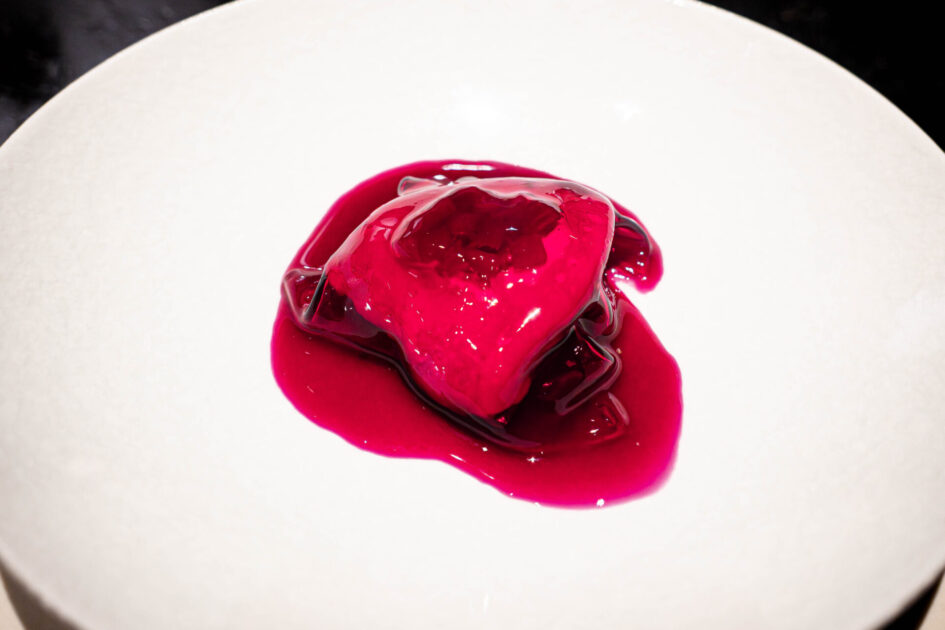CONTENTS
About Florilège
Concept
In 2023, Florilège relocated from Jingumae to Azabudai Hills, deepening its sustainable approach to French gastronomy in harmony with the new district’s core concept of “Green & Wellness.”
At the heart of its cuisine lies a plant-based philosophy that embraces vegetables and plant-derived ingredients, while maintaining a balanced use of meat, fish, and dairy. Rather than pursuing a strictly vegan menu, the restaurant aims to reduce environmental impact through diversity and flexibility. Even from familiar vegetables, new flavors are drawn out through the skillful use of fermentation and acidity, resulting in dishes that leave a lasting impression.
Florilège also adopts the “table d’hôte” style, where all guests share one large communal counter that surrounds the open kitchen. This design allows diners to feel the presence of the chefs and staff up close, creating a seamless connection between food, space, and consciousness. The restaurant has been awarded two Michelin stars and the coveted Green Star, attracting worldwide attention as a model for environmentally mindful fine dining.
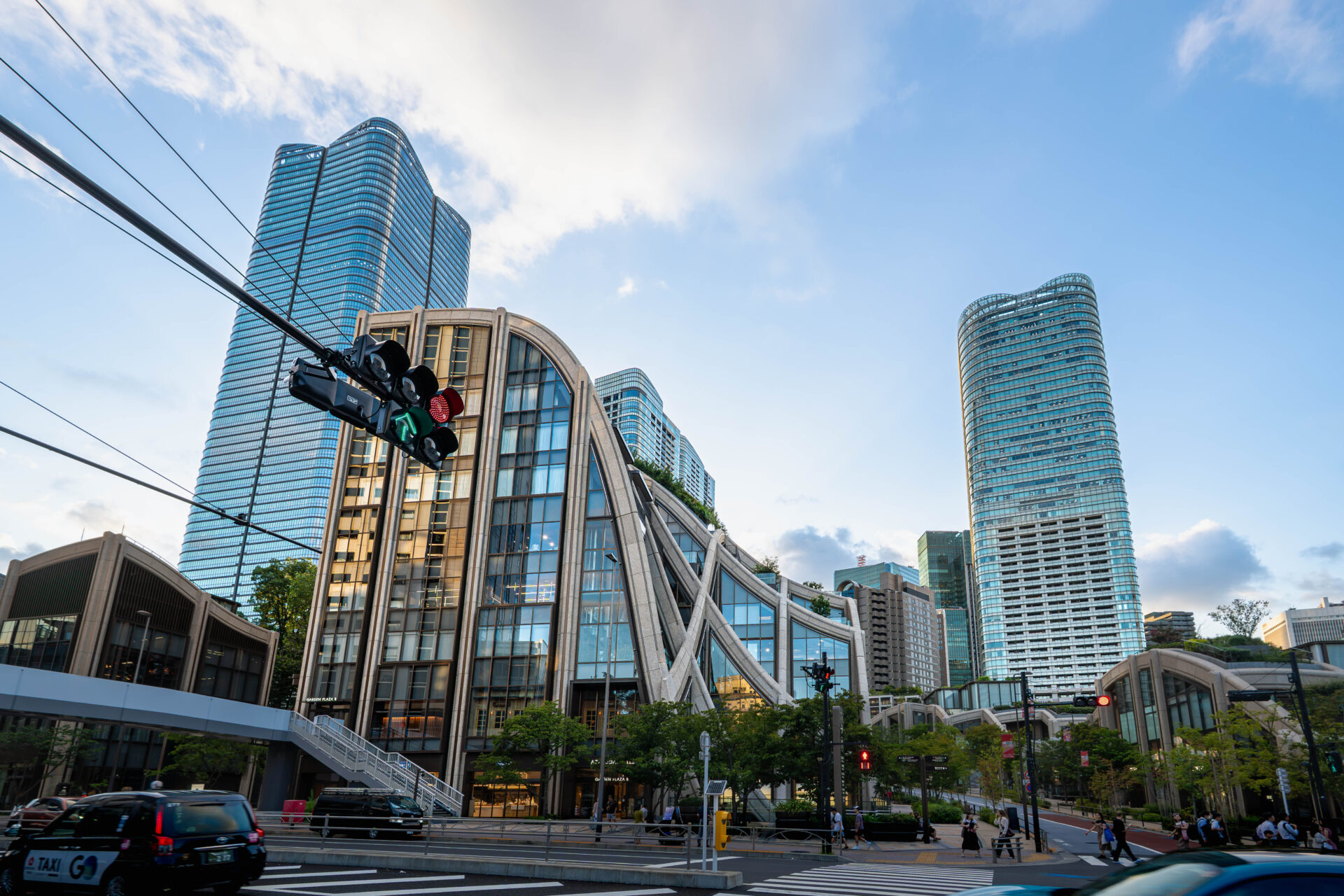
Chef: Hiroyasu Kawate
Born in Tokyo in 1978, Chef Hiroyasu Kawate honed his craft at renowned establishments such as Le Bourguignon in Nishi-Azabu, Jardin des Sens in Montpellier, France, and Quintessence in Shirokanedai. He opened his own restaurant in Minami-Aoyama in 2009, relocated to Jingumae in 2015, and finally to Azabudai Hills in 2023.
Questioning the excesses of traditional fine dining, Chef Kawate shifted his focus toward sustainability through his encounters with Japanese producers and local ingredients. His flexible approach—placing vegetables at the center while still incorporating meat and fish—represents a realistic and thoughtful vision of sustainable gastronomy.
With the move to Azabudai Hills came a complete renewal of the kitchen and facilities, improving the working environment for staff and enhancing the guest experience. The simultaneous recognition of two Michelin stars and the Green Star underscores the global respect for Kawate’s philosophy and practice.
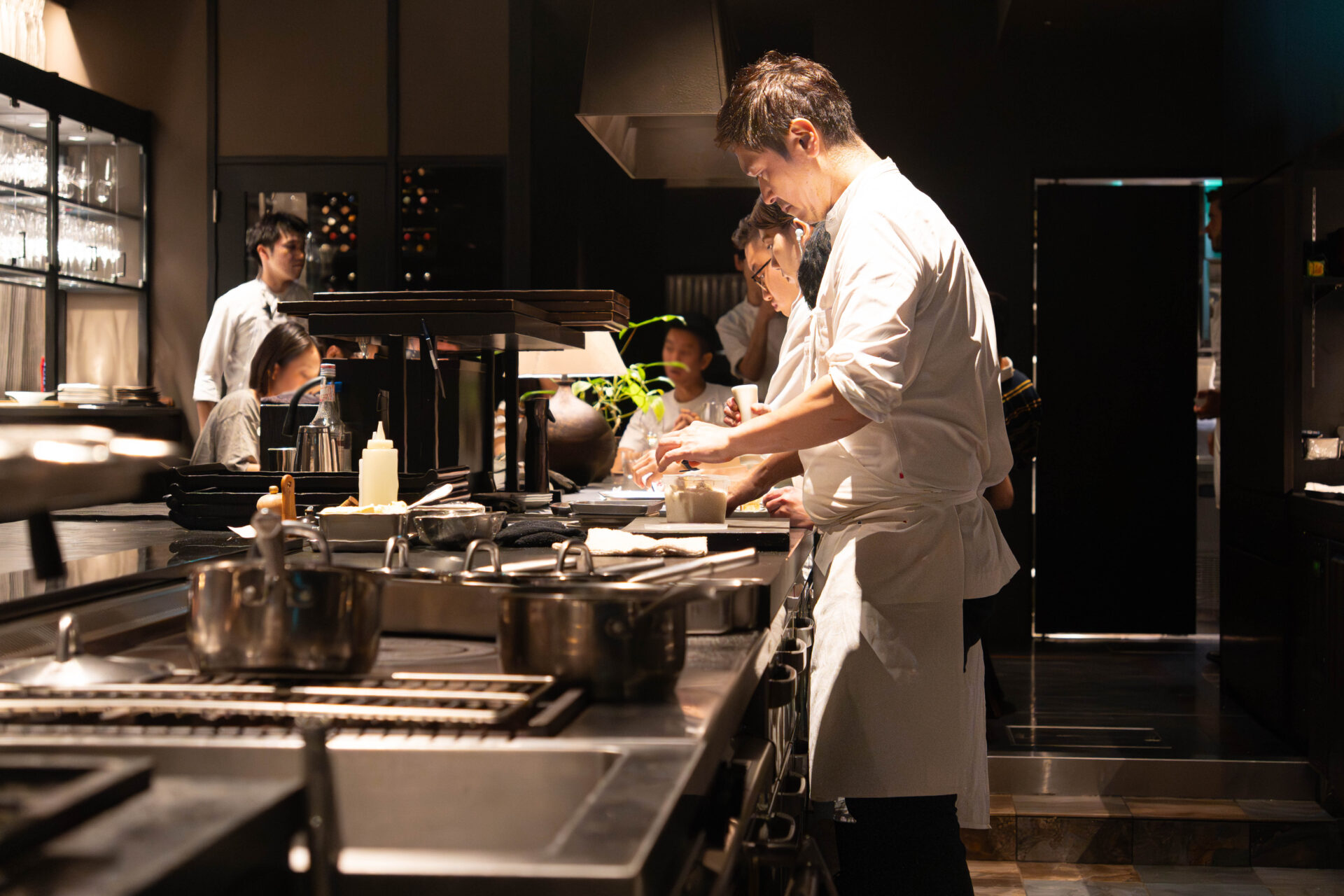
Restaurant Recognition
Florilège has consistently received high acclaim both domestically and internationally. It maintains two Michelin stars in the Michelin Guide Tokyo and has earned the Green Star for its commitment to environmental consciousness, demonstrating excellence in both culinary artistry and sustainability.
In the prestigious Asia’s 50 Best Restaurants list, Florilège ranked 2nd in Asia in 2024 and 17th in 2025, cementing its reputation as one of Asia’s leading French restaurants. It has also appeared on The World’s 50 Best Restaurants, affirming its global recognition and influence.
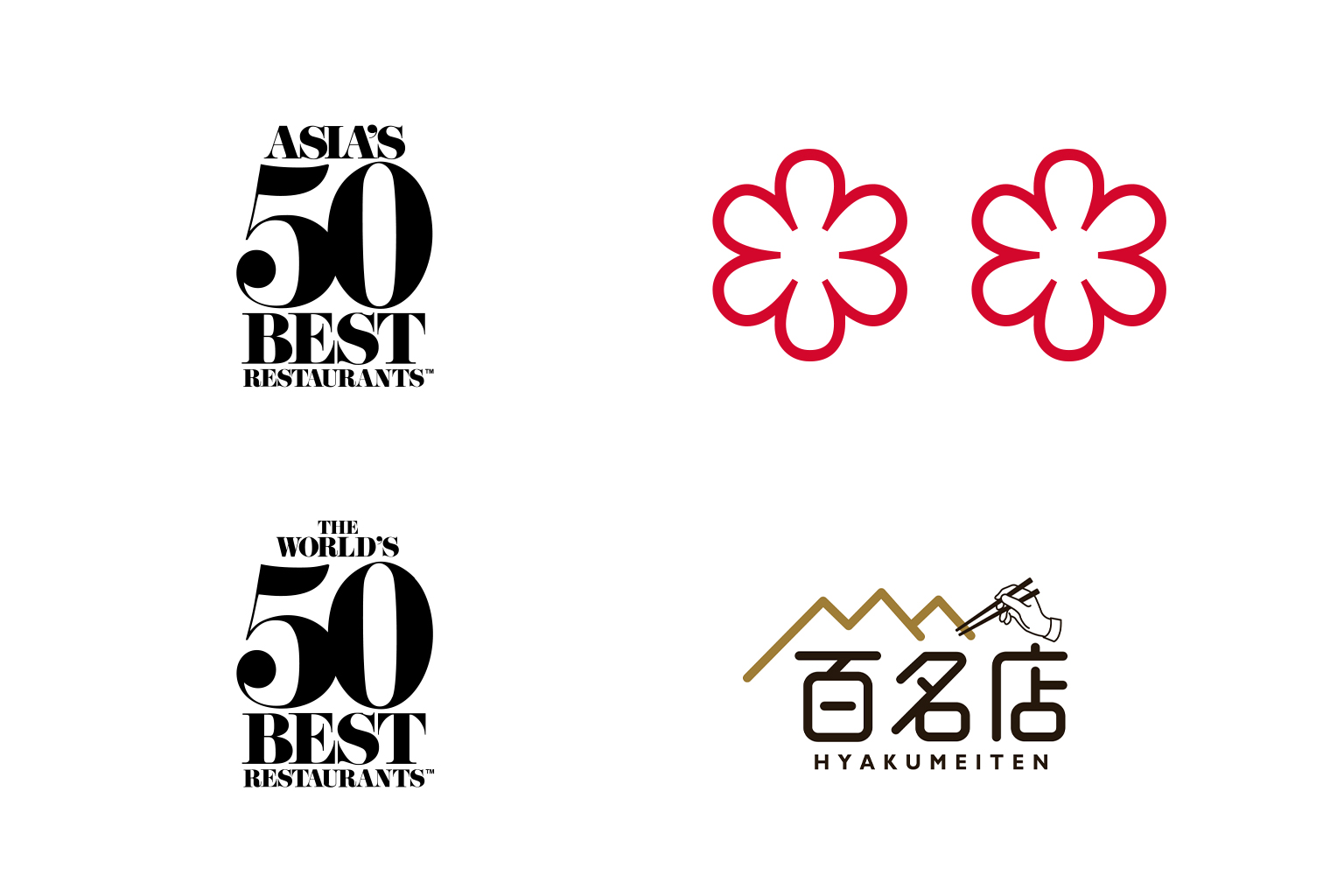
Dining Prelude
Exterior & Entrance
The entrance to Florilège blends quietly into the refined streetscape of Azabudai Hills—there is no ostentatious sign or decoration. Only a small engraved logo on the wall discreetly announces the doorway to an extraordinary experience within.
Stepping inside, guests are welcomed into a calm reception space unified by soft tones and warm lighting. On the wall, an array of plaques—two Michelin stars, the Green Star, and honors from The World’s 50 Best Restaurants—tell the story of the restaurant’s journey and recognition. Subtle details such as trophies and small figurines on the counter add a playful human touch amid the sophisticated atmosphere.
The design, though minimal, naturally draws guests toward the culinary stage that lies ahead. Beneath the quiet elegance, an undeniable sense of presence sets the tone for the exceptional dining experience to follow.
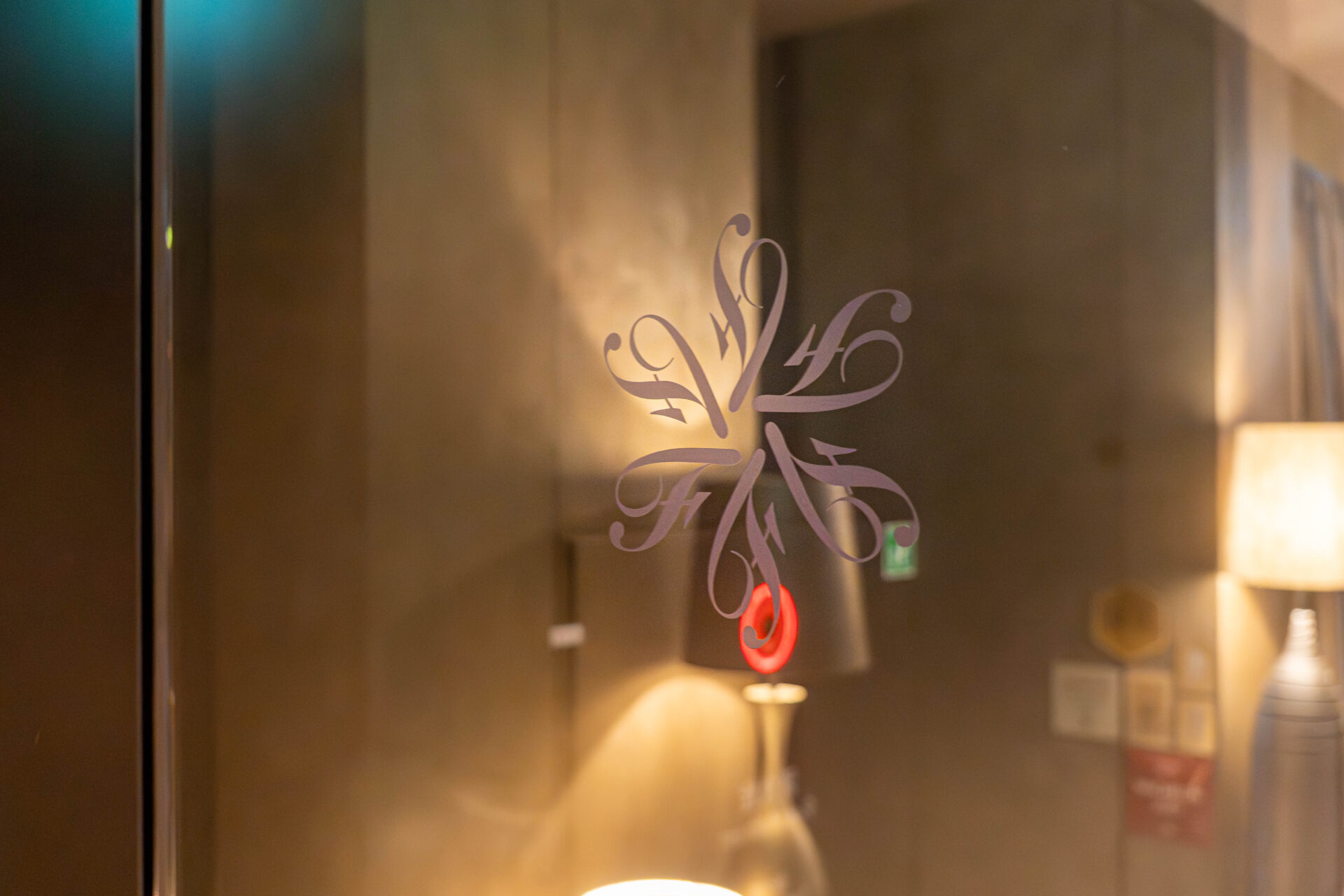
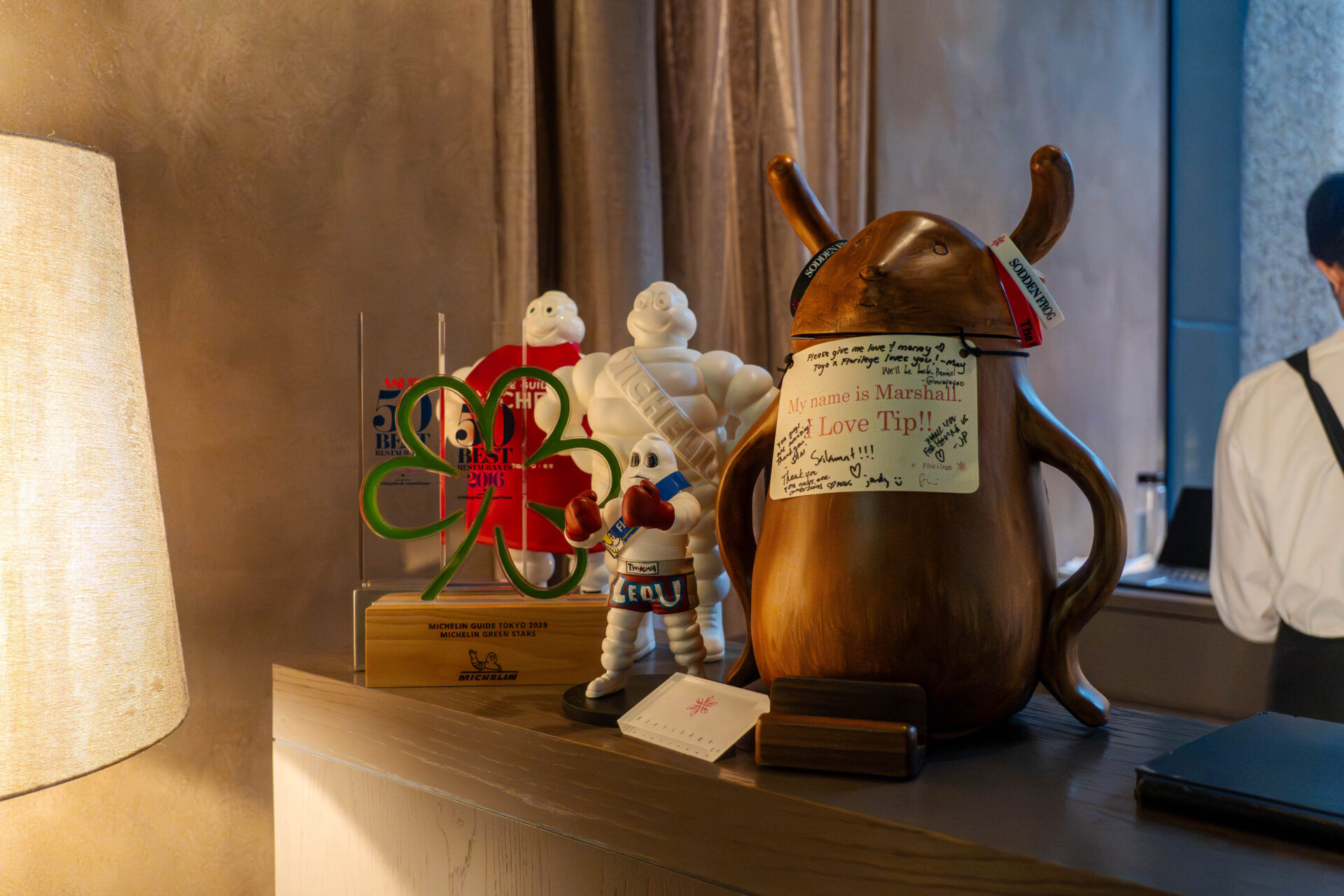
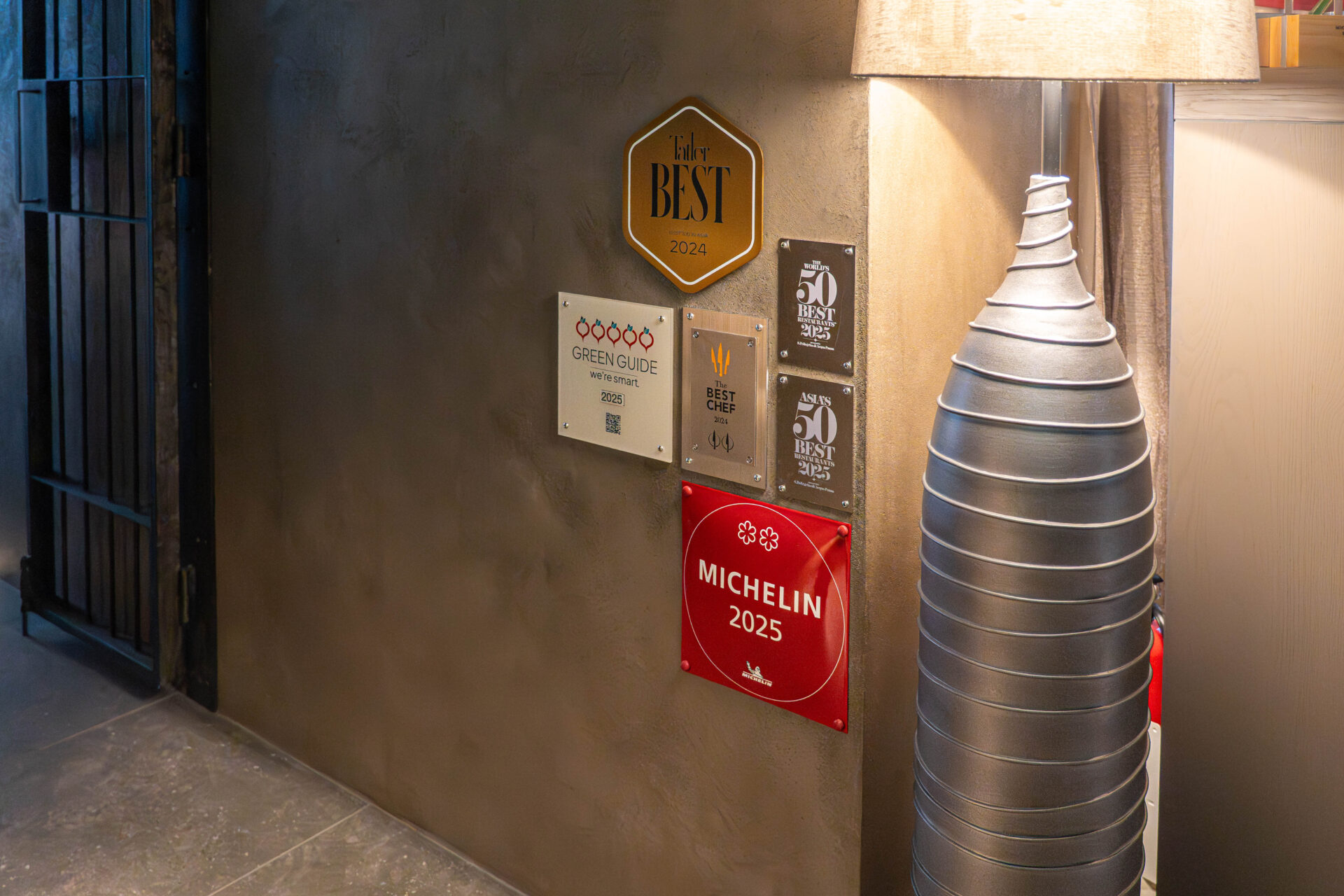
Table d’Hôte — The Signature Dining Style of Florilège
The dining room of Florilège is defined by its table d’hôte concept: all guests sit around a single, expansive wooden counter that surrounds the open kitchen. Instead of individual tables, this communal setting fosters a sense of unity among diners, as they share the same time and space in an intimate yet lively environment.
At the center of the table lies the kitchen itself. Every gesture—the finishing of a sauce, the plating of a dish, the sound and aroma rising from the stove—becomes part of the sensory experience. It’s a design made to savor the live energy of cooking.
This format also brings guests closer to one another and to the chefs. Conversations naturally arise, and the proximity allows diners to learn about the stories and intentions behind each dish directly from the creators. Through this interaction, the experience transcends the act of eating—it becomes a dialogue about food, philosophy, and craft.
More than a place to dine, Florilège’s table d’hôte serves as a stage for shared exploration. It embodies the restaurant’s philosophy: a meeting point where cuisine, people, and time converge in harmony.
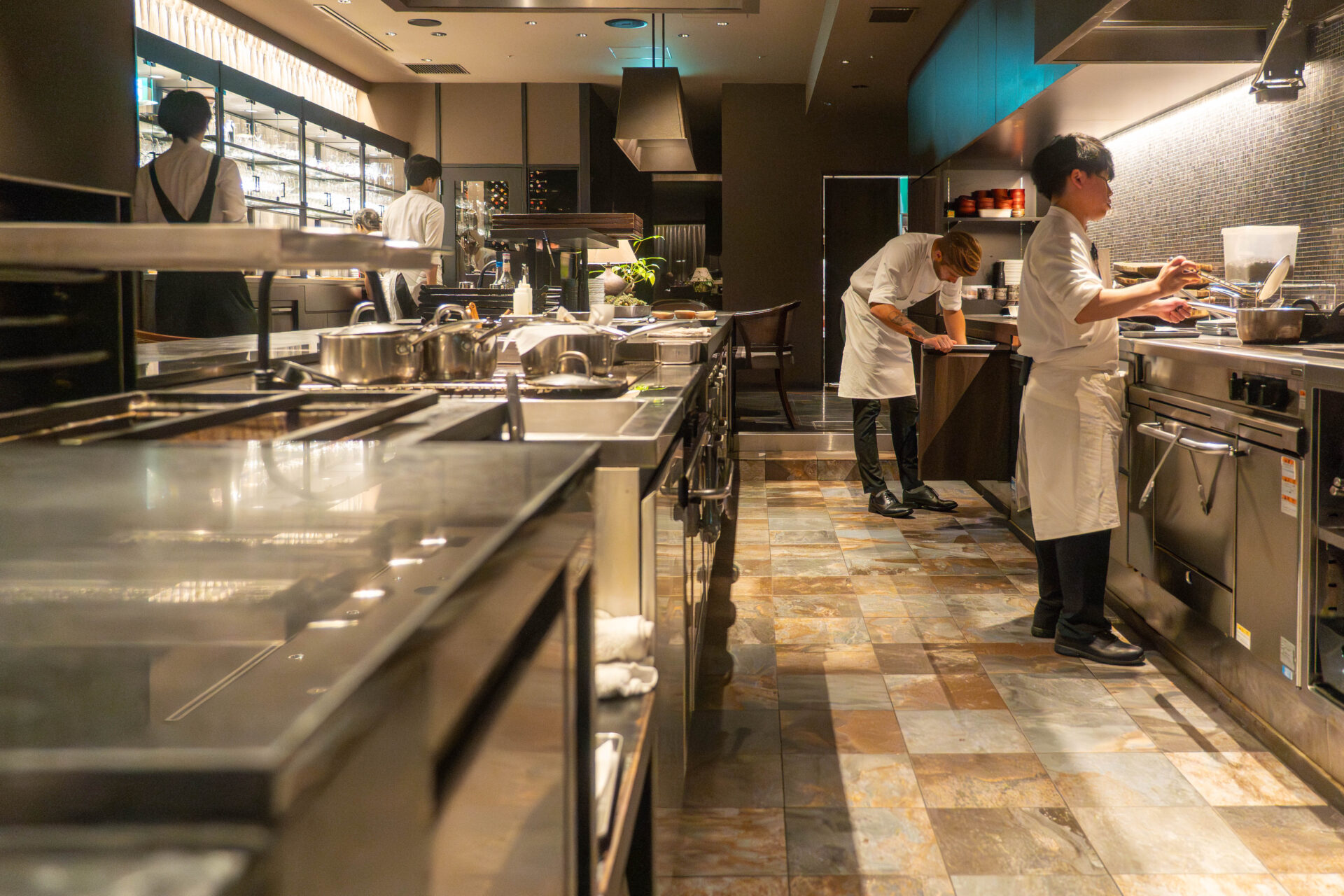
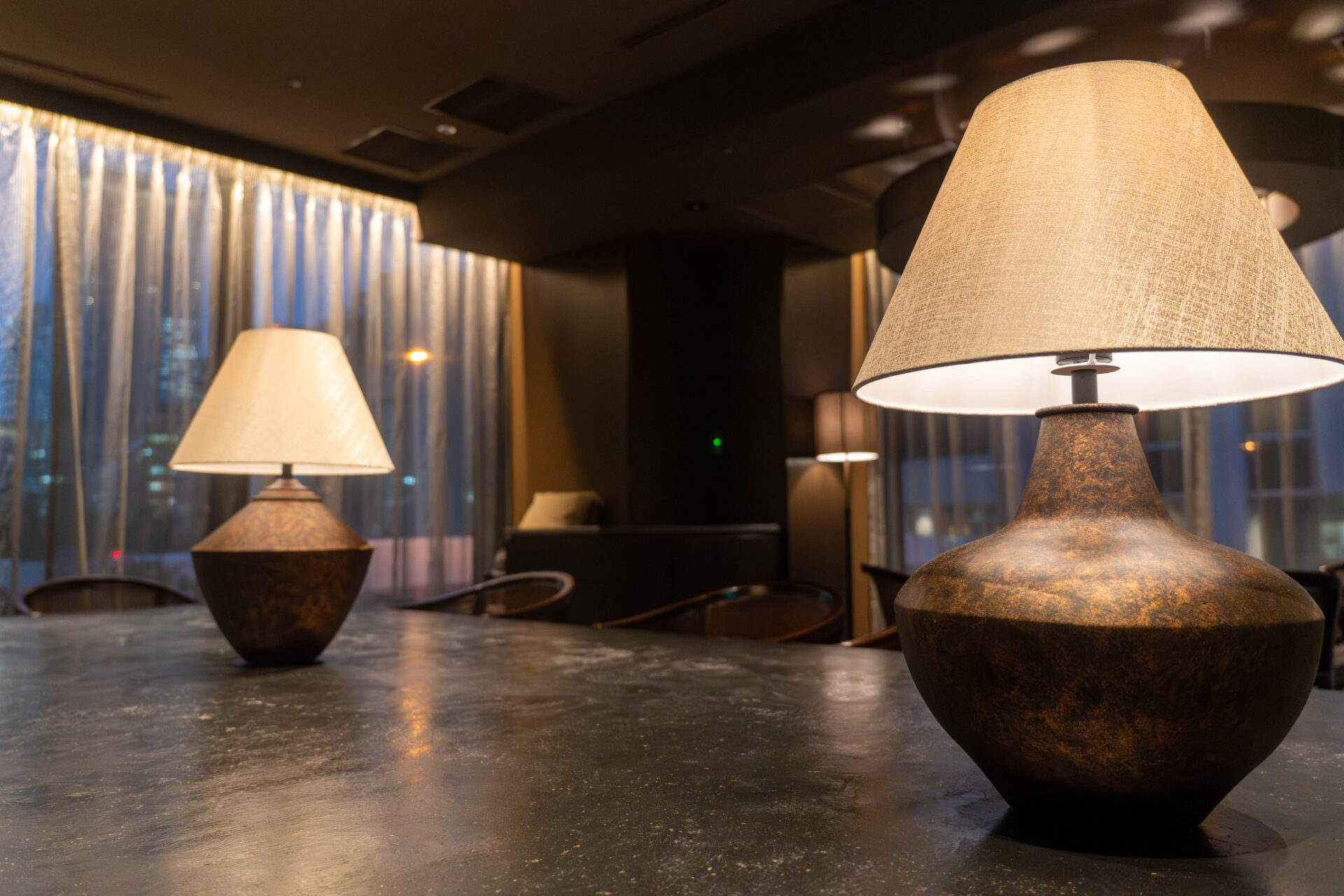
Menu Presentation
At Florilège, the tasting course is more than a sequence of dishes—it is a form of storytelling, crafted to communicate the chef’s ideas and seasonal themes through sight, sound, and taste.
1. A Shared Table Experience
- The restaurant’s heart is the large counter table where all guests are seated together in the table d’hôte style.
- The open kitchen unfolds directly in front of the diners, offering a full view of the chefs at work.
- The presentation begins even before the dish is served—the process itself is part of the performance.
2. Narrative-Driven Menu
- The course unfolds like a story, weaving together seasonality, Japanese terroir, and respect for producers.
- Dishes such as “Watermelon and Tomato Gazpacho” or “Vinegared Horse Mackerel with Fermented Cabbage” reinterpret everyday ingredients through a creative lens, surprising with new harmonies.
- By spotlighting the beauty of simple materials, the menu conveys a deeper message about the essence of food.
3. Approach to Ingredients
- Rather than relying on luxurious ingredients, Florilège elevates humble vegetables and fish to starring roles.
- Each ingredient is chosen with purpose—often accompanied by a story about its origin or producer.
- The chef explains the reasoning behind each selection, enriching the dining experience through both flavor and knowledge.
4. Presentation and Service
- The final touches—pouring sauces tableside, infusing herbs, or releasing aromatic oils—are integral to the sensory presentation.
- These gestures heighten not only the beauty of the dish but also the memory of the moment.
- Service at Florilège is interactive; through conversation and engagement, a genuine connection is built between staff and guests.
5. A Thoughtful Finale
- The course concludes gently, often with small confections or tea that evoke calm reflection.
- This lingering finish ensures that the memory of the meal extends beyond the final bite.
Overall, the presentation at Florilège transcends the act of eating. It invites guests to see, listen, and think—transforming the dining room into a shared stage where chefs and diners co-create a living narrative.
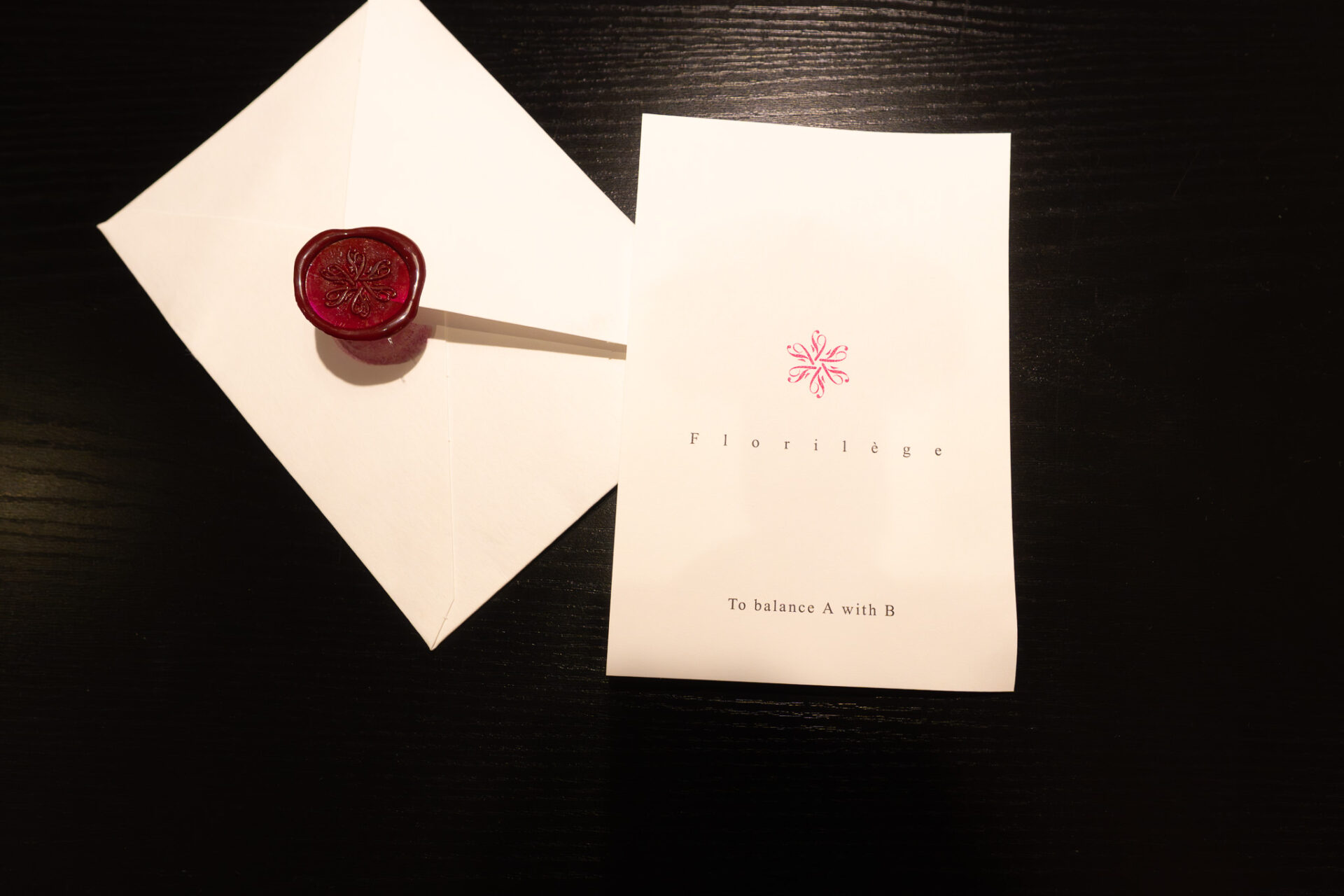
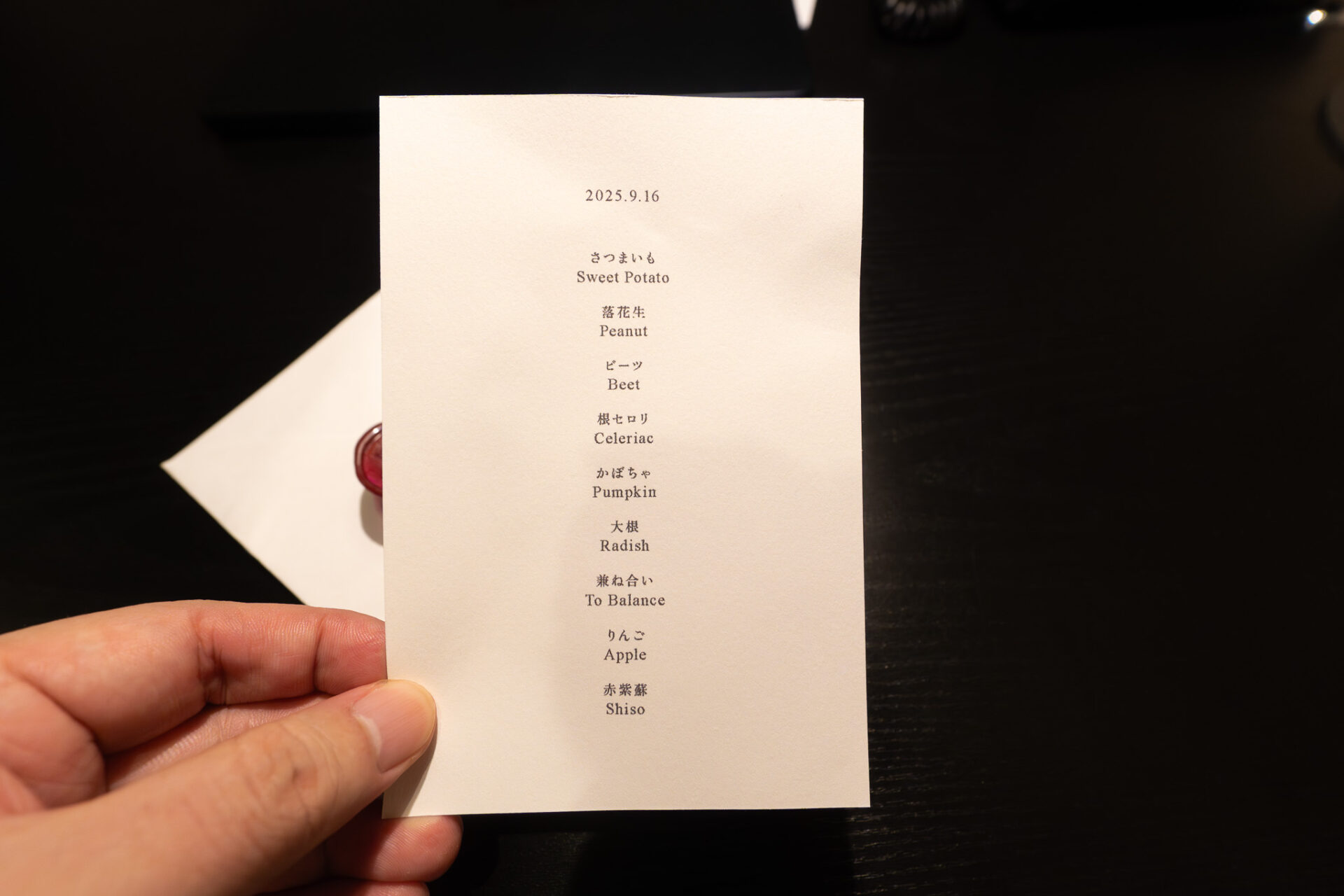
Starter Drink
Once seated, the meal begins with a choice of drinks to accompany the course. Guests can select from a wide range of alcoholic and non-alcoholic pairings. On this visit, the non-alcoholic pairing was chosen.
The first glass presented was a seasonal creation featuring Japanese pear — a gentle golden hue reminiscent of Champagne. Its delicate sweetness was balanced with the soft aroma of honey and subtle notes of birch, evoking a refreshing sense of forest air beneath the fruit’s natural brightness.
Even without alcohol, it perfectly set the stage for the meal ahead — elegant, seasonal, and full of narrative depth. It was a fitting prelude to Florilège’s story-driven approach to dining.
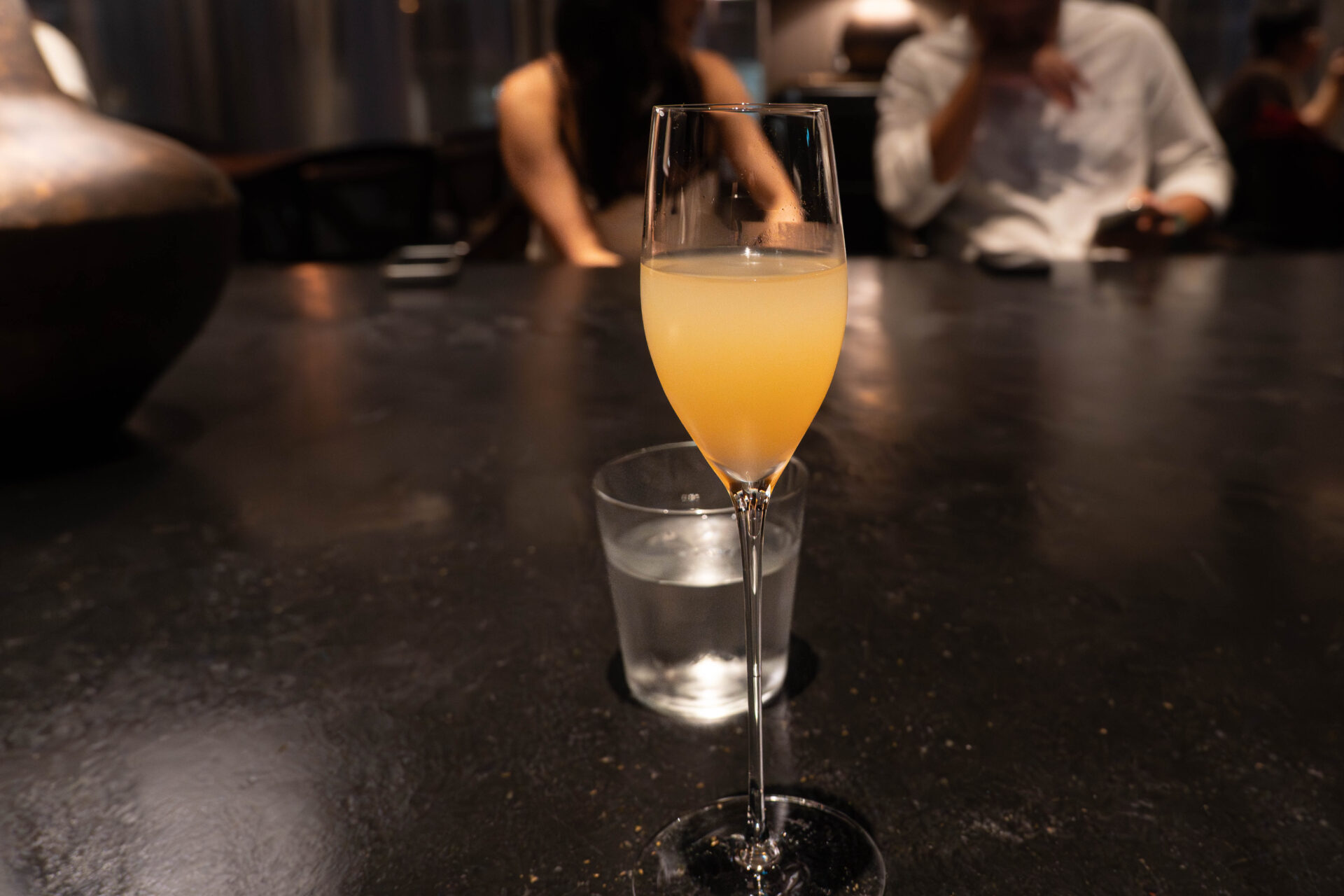
Tasting Menu
Amuse-bouche
The meal opened with two expressions of sweet potato, celebrating the flavors of autumn.
The first was a clear sweet potato consommé, shimmering amber in color, distilled from roasted sweet potatoes to extract their earthy sweetness. A touch of vanilla cream on top added warmth and roundness, resulting in a cup that was both comforting and profound.
The second amuse came playfully hidden: a baked sweet potato skewered like a twig and nestled in a bed of tea leaves mimicking fallen autumn foliage. The outer layer was made from purple sweet potato, encasing a core of Gorō Kintoki from Ishikawa Prefecture. The contrast of textures and the nostalgic roasted aroma evoked the feeling of eating yaki-imo by a campfire — whimsical yet refined.
Together, these two courses gently introduced the themes of seasonality and sensory engagement that define Florilège’s cuisine.
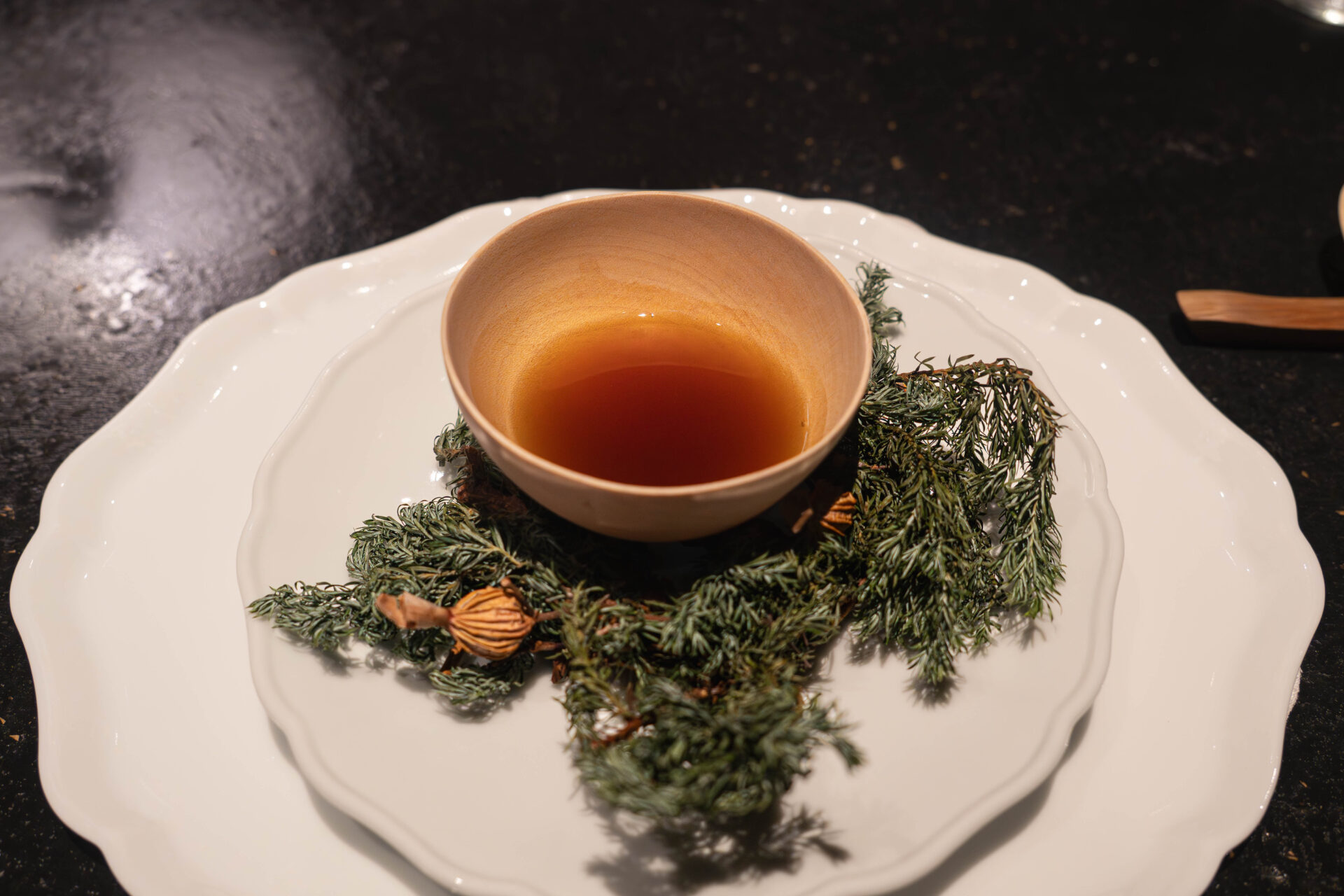
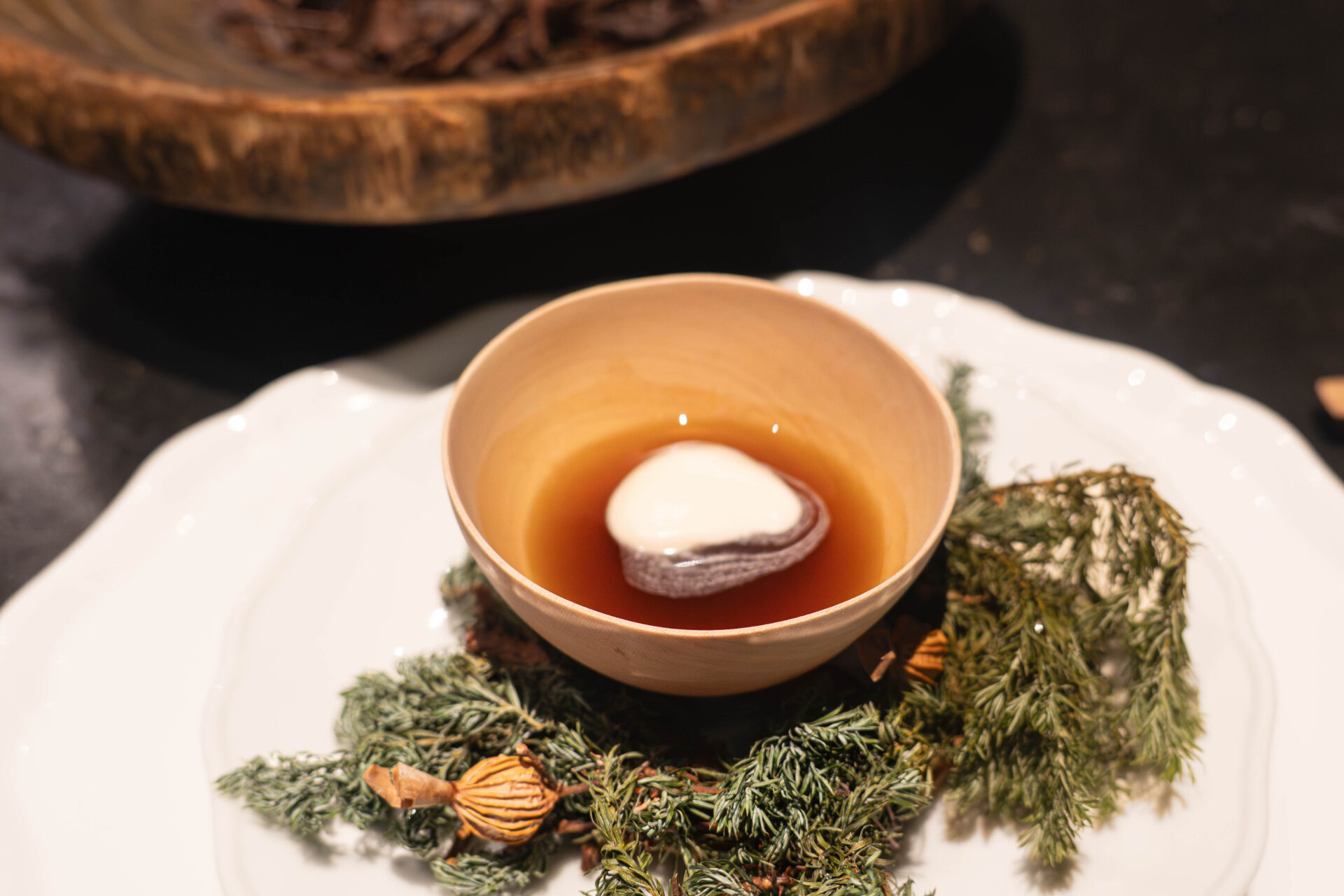
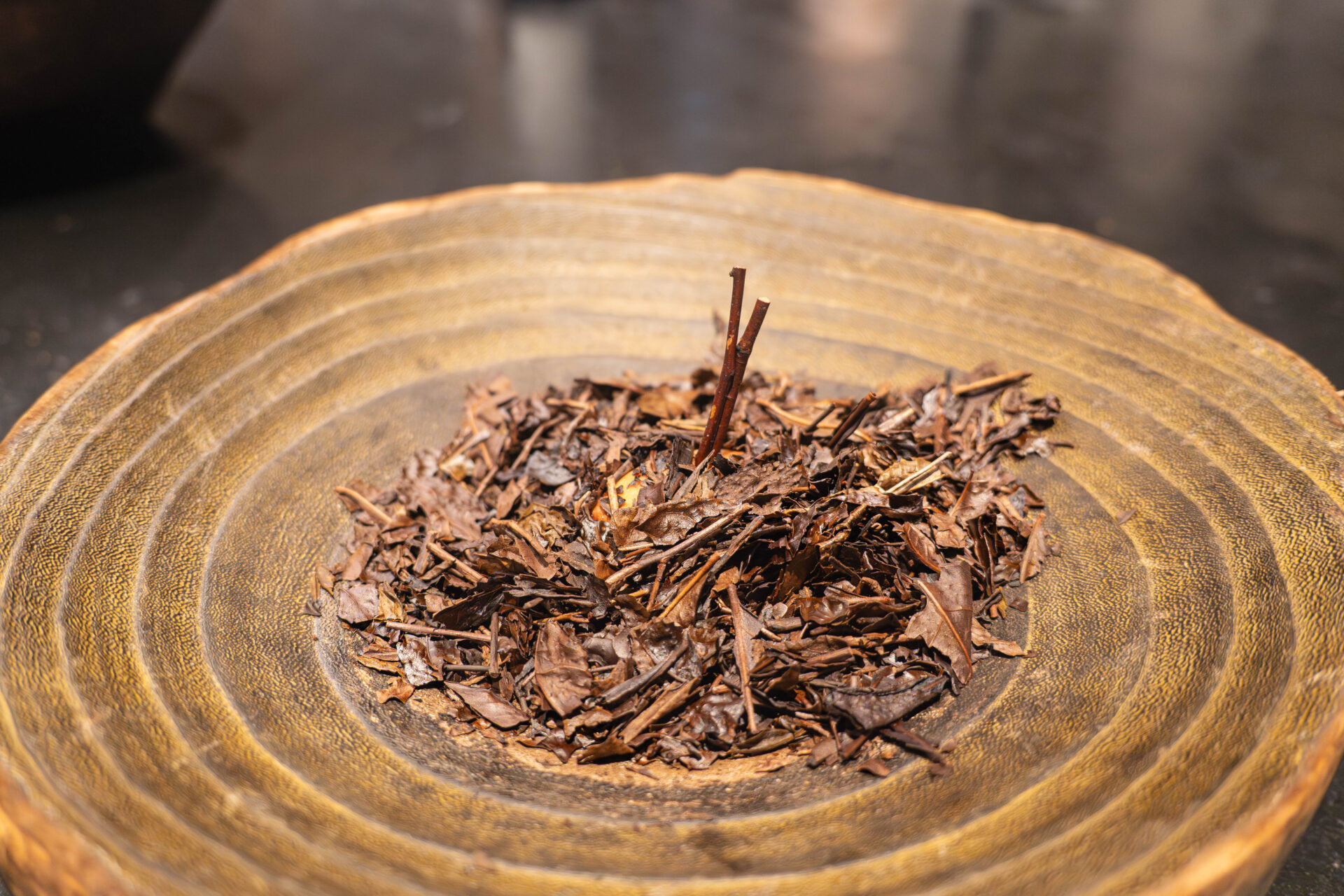
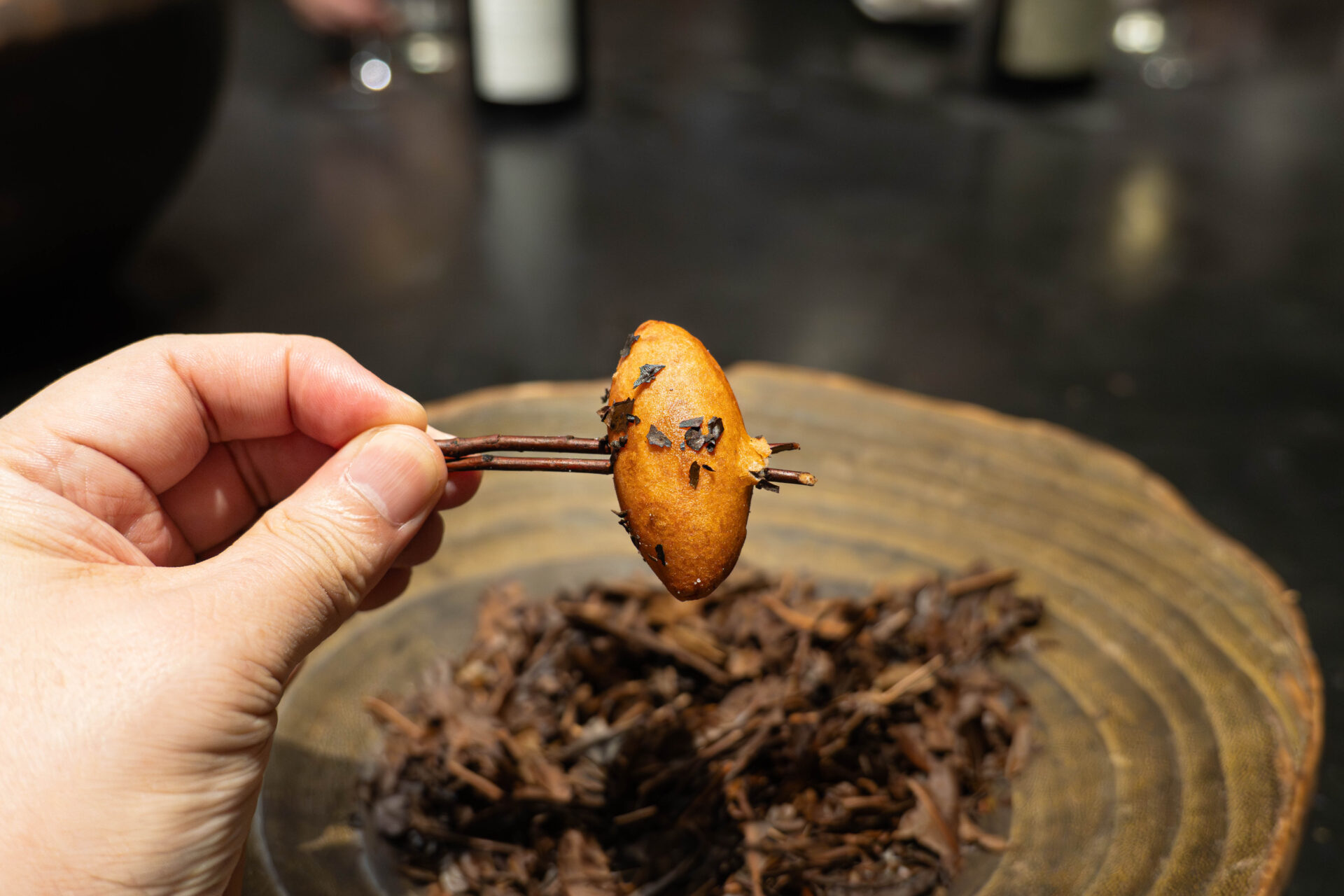
Blancmange of Peanuts and Vegetable Carpaccio
The next course came as a duo: a peanut blancmange paired with a colorful vegetable and fruit carpaccio.
The blancmange was silky and aromatic, served with a sauce of kabosu and zest for a touch of citrus brightness. The richness of the peanuts and the crisp acidity of the citrus danced harmoniously on the palate.
Behind it, thinly sliced tomato, Shine Muscat, and okra were arranged with micro herbs, creating a vivid and refreshing contrast. Guests were encouraged to combine the carpaccio with the blancmange, layering fruits and vegetables over the creamy base for a medley of flavors that evolved with each bite.
The pairing for this course was a non-alcoholic cocktail of muscat grapes and Manganji peppers, with lime for a touch of zest. The sweetness of the muscat enhanced the dish’s fruity tones, while the green notes of the pepper and the citrus’s sharpness refreshed the palate beautifully.
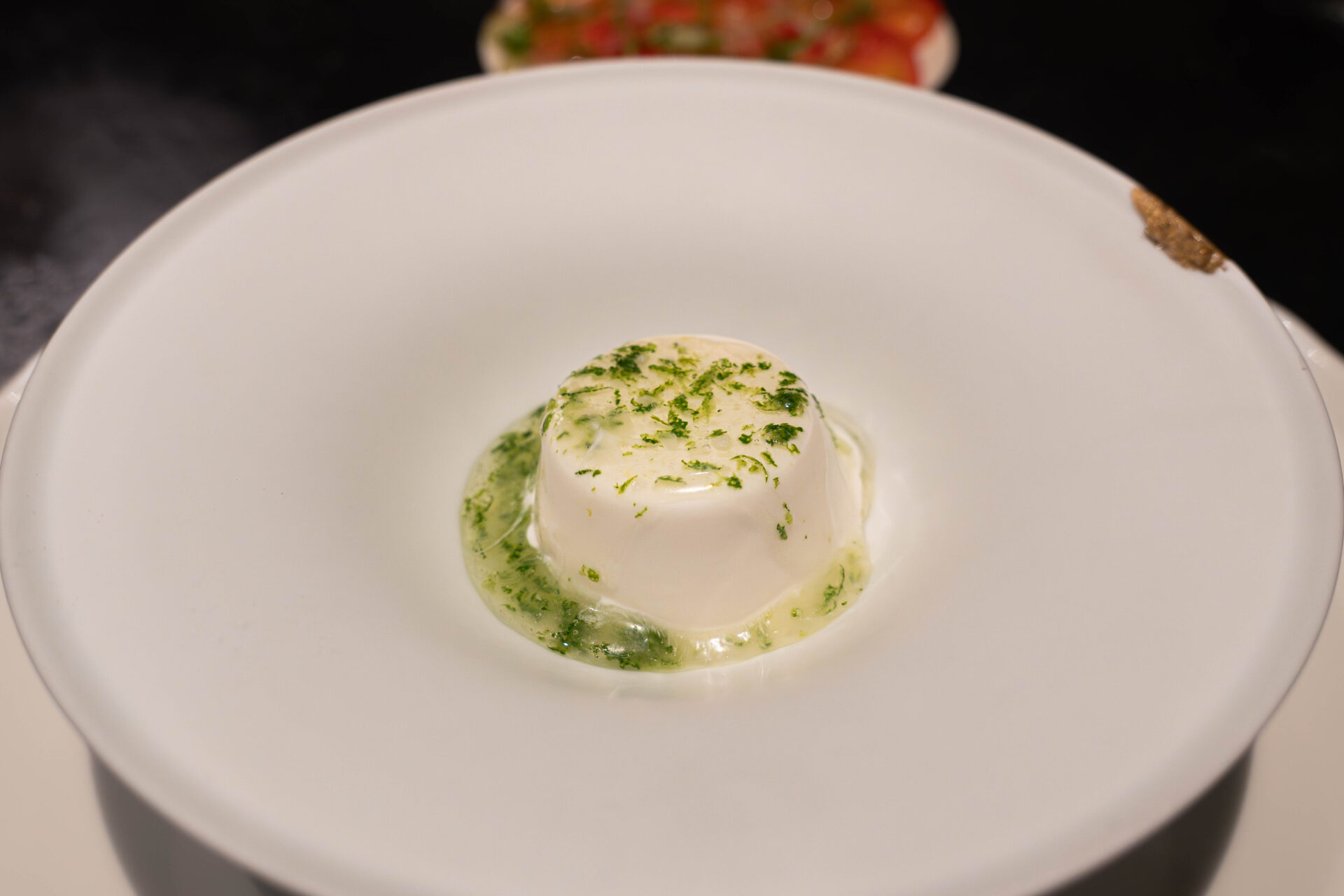
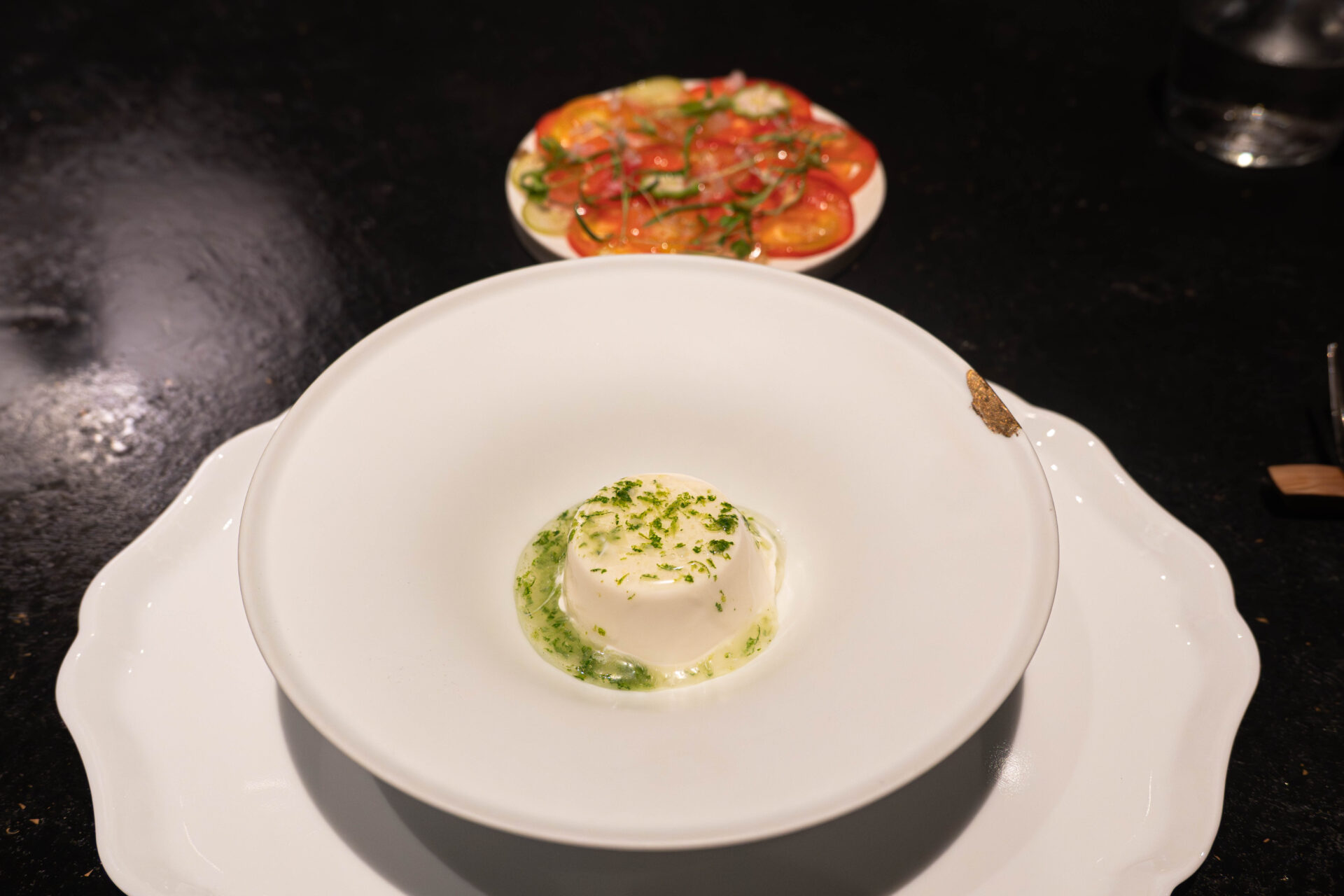
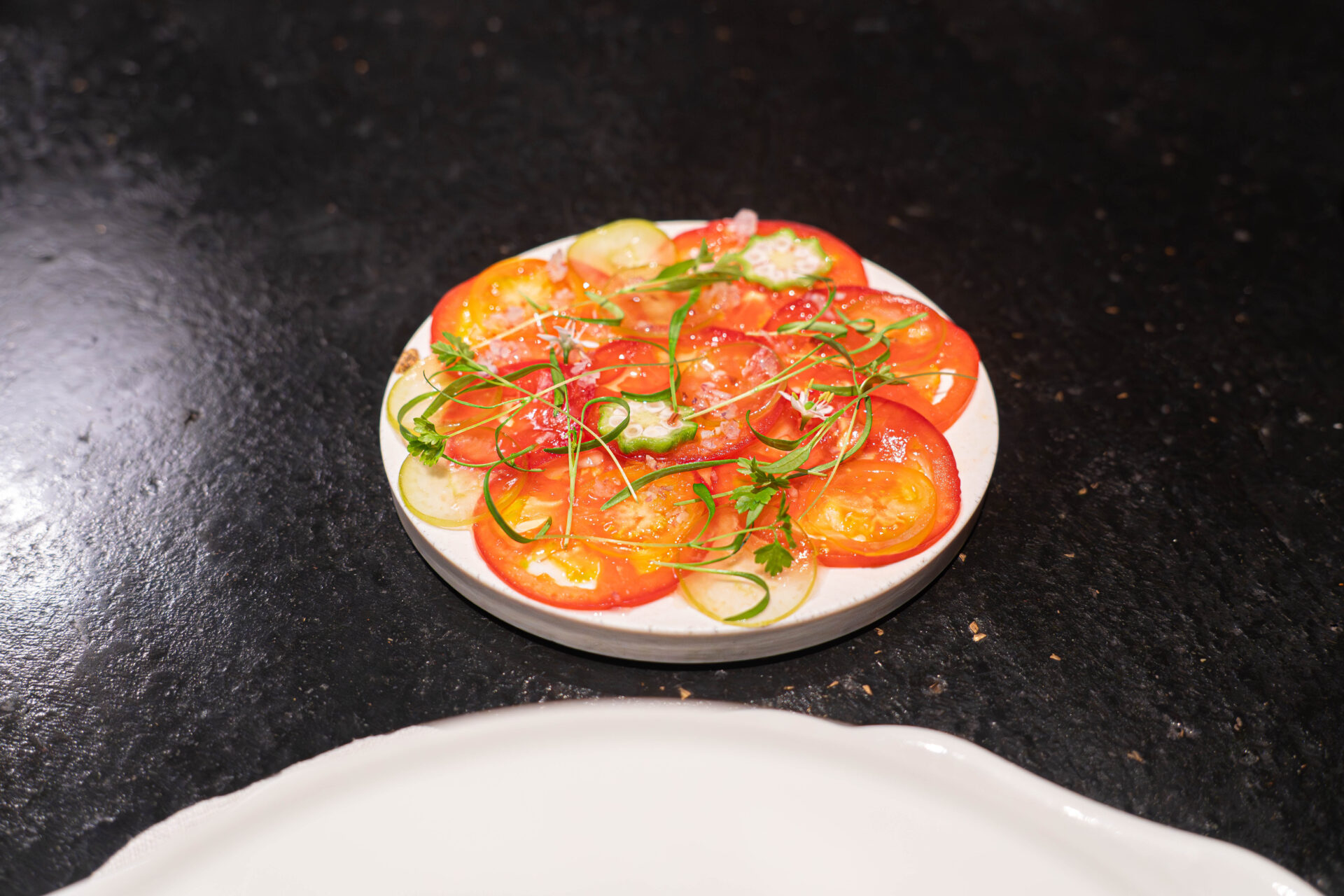
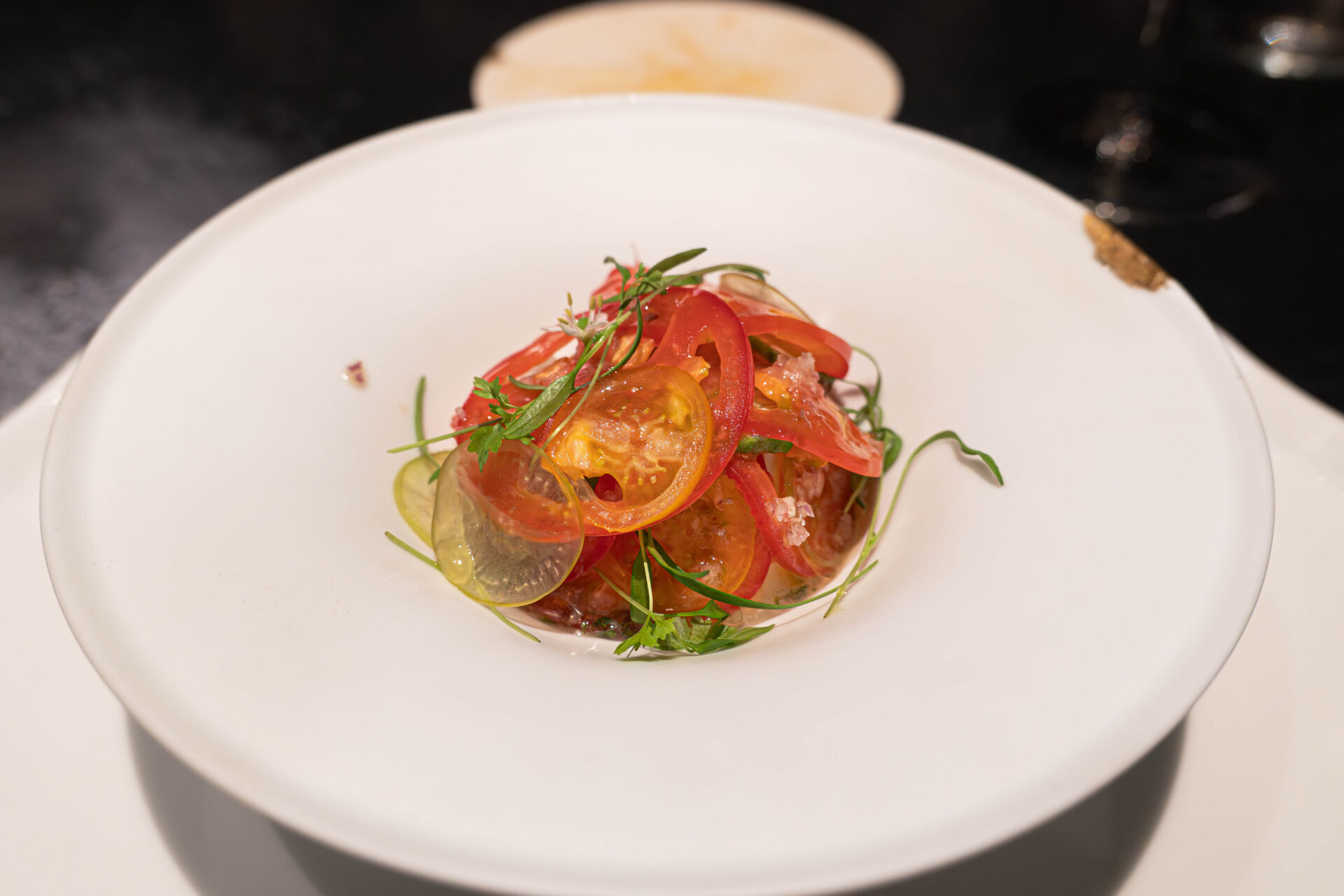
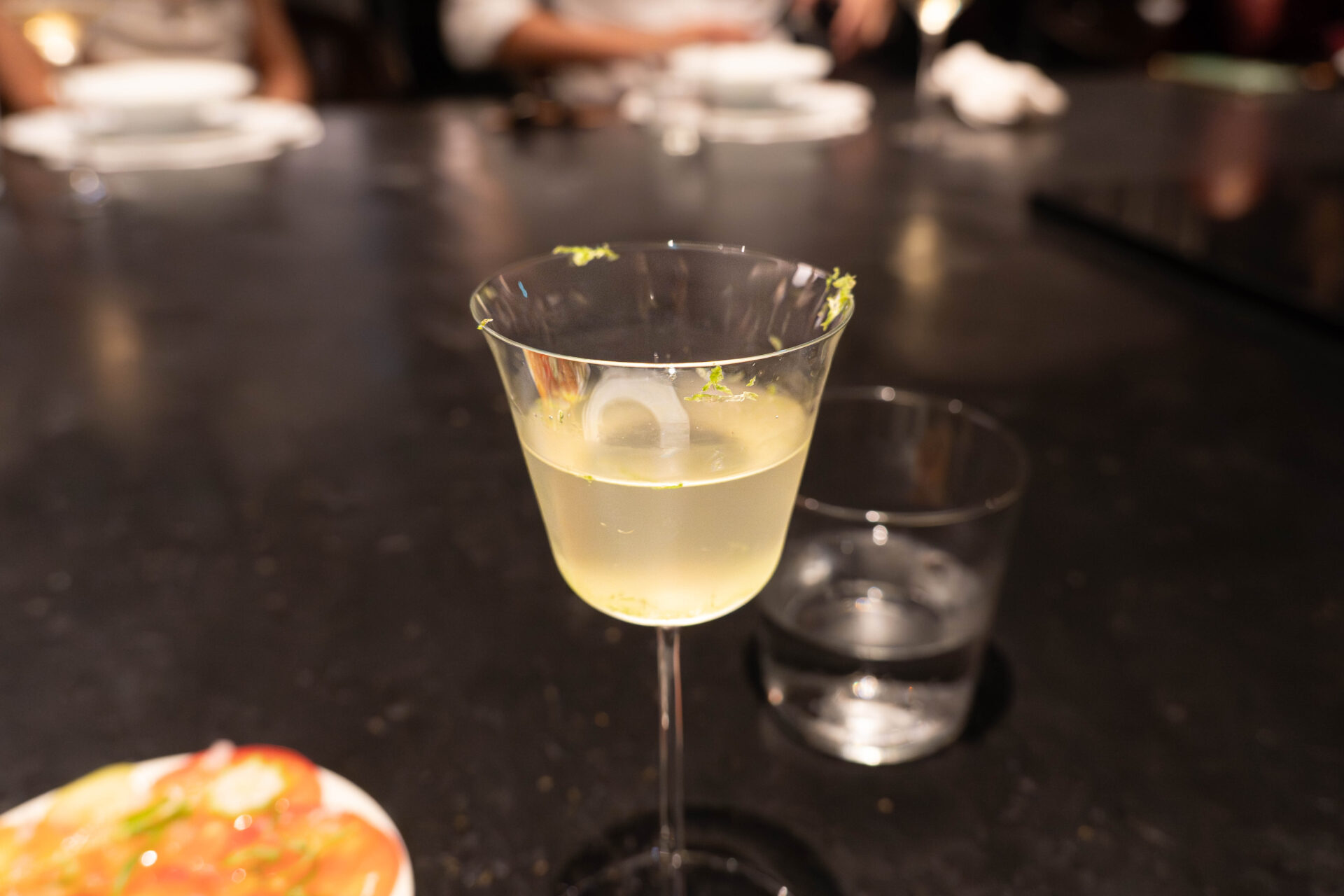
Beetroot and Salmon Roe
This visually striking dish centered on the deep crimson of beetroot. On one side was salt-baked beetroot; on the other, a tartare of finely chopped beets topped with vivid ikura (salmon roe). Beneath it all lay a rich egg yolk-based sauce that added depth and umami.
A separate plate of crème d’Anjou brought creamy acidity that completed the dish’s balance, elevating the sweetness of the beets and the brininess of the roe.
Paired with a pomegranate and cranberry mocktail, the drink mirrored the dish’s red hue and lively acidity. Garnished with mild mizuna leaves softened in water to reduce heat, it added herbal freshness that brought the flavors together seamlessly.
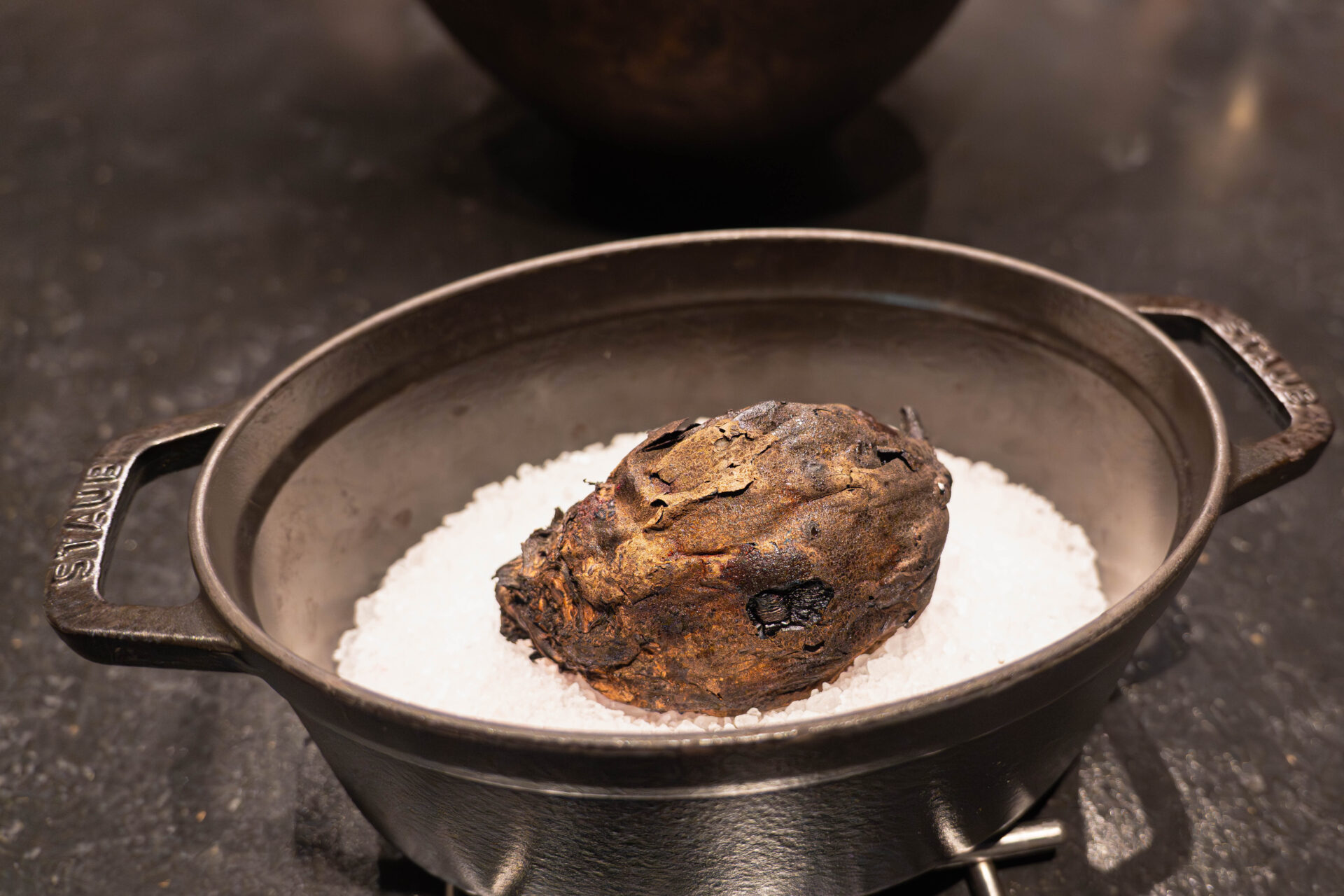
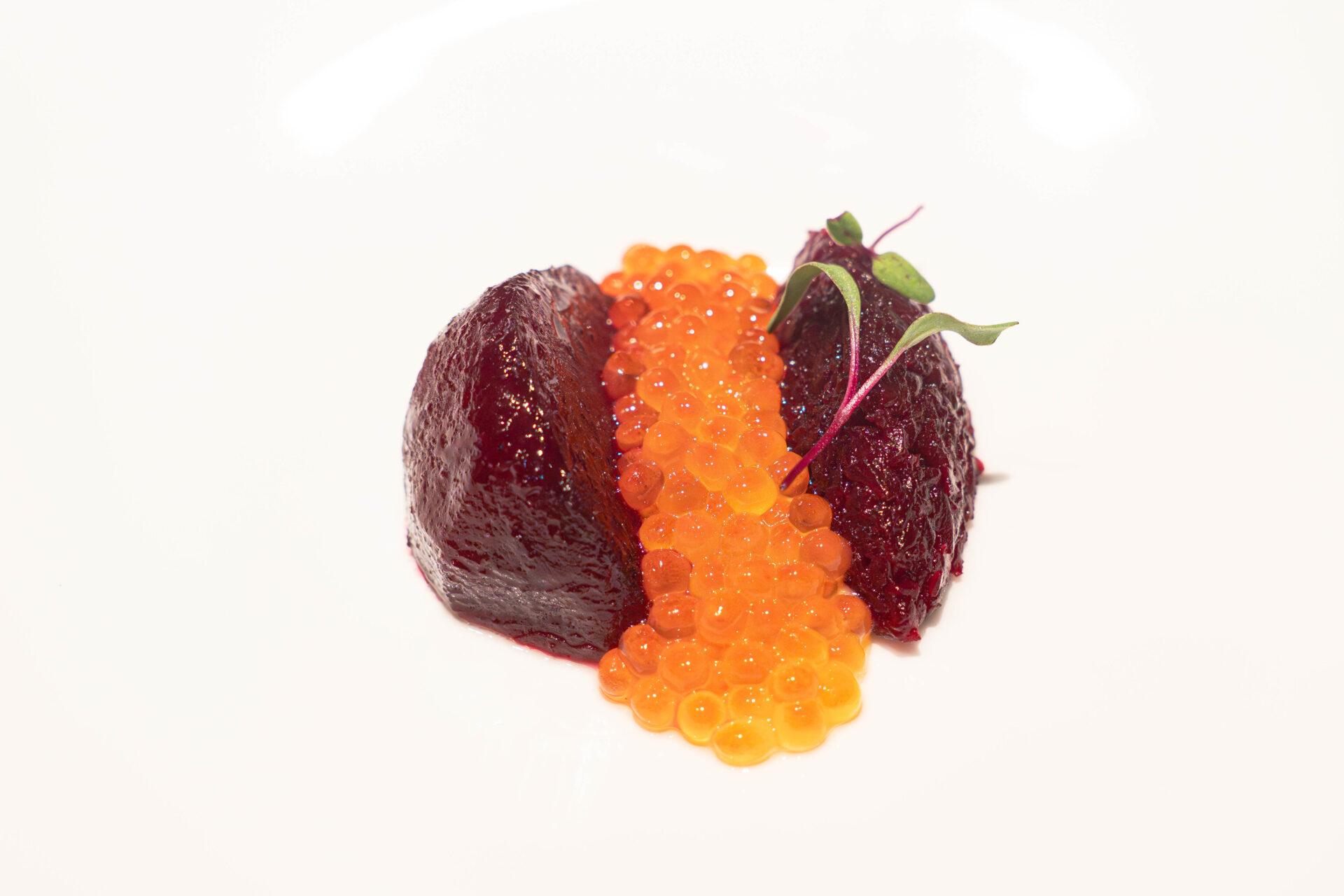
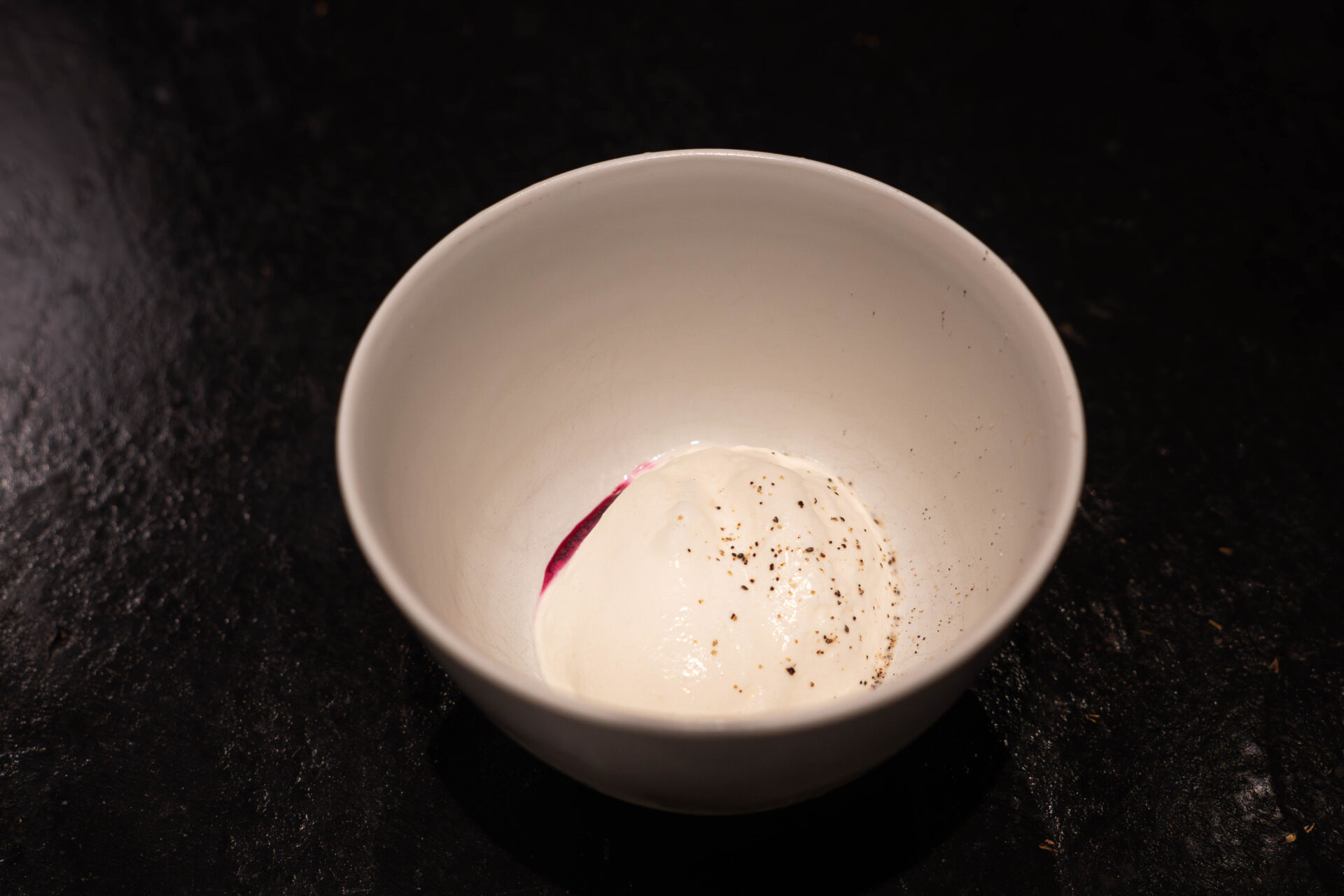
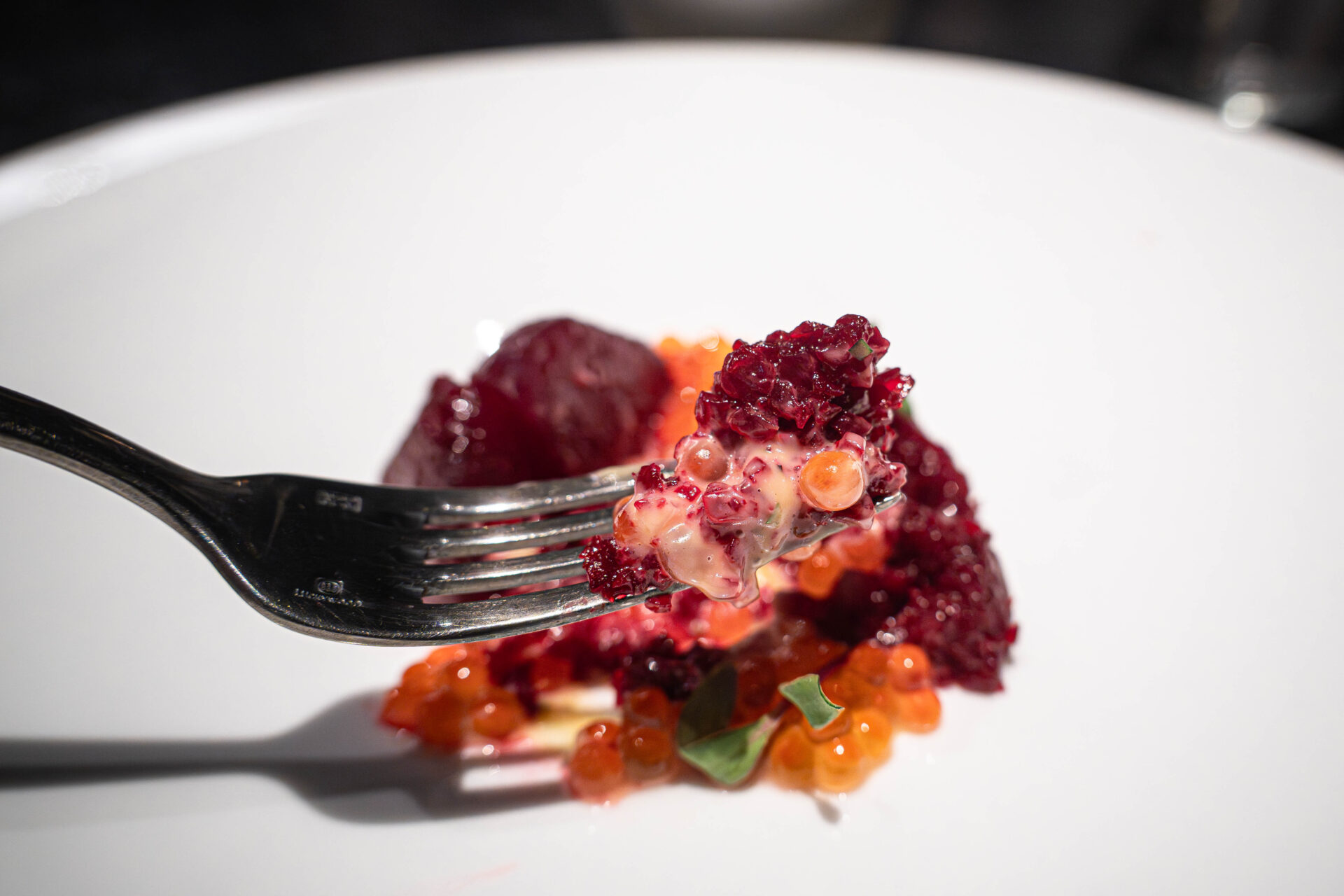
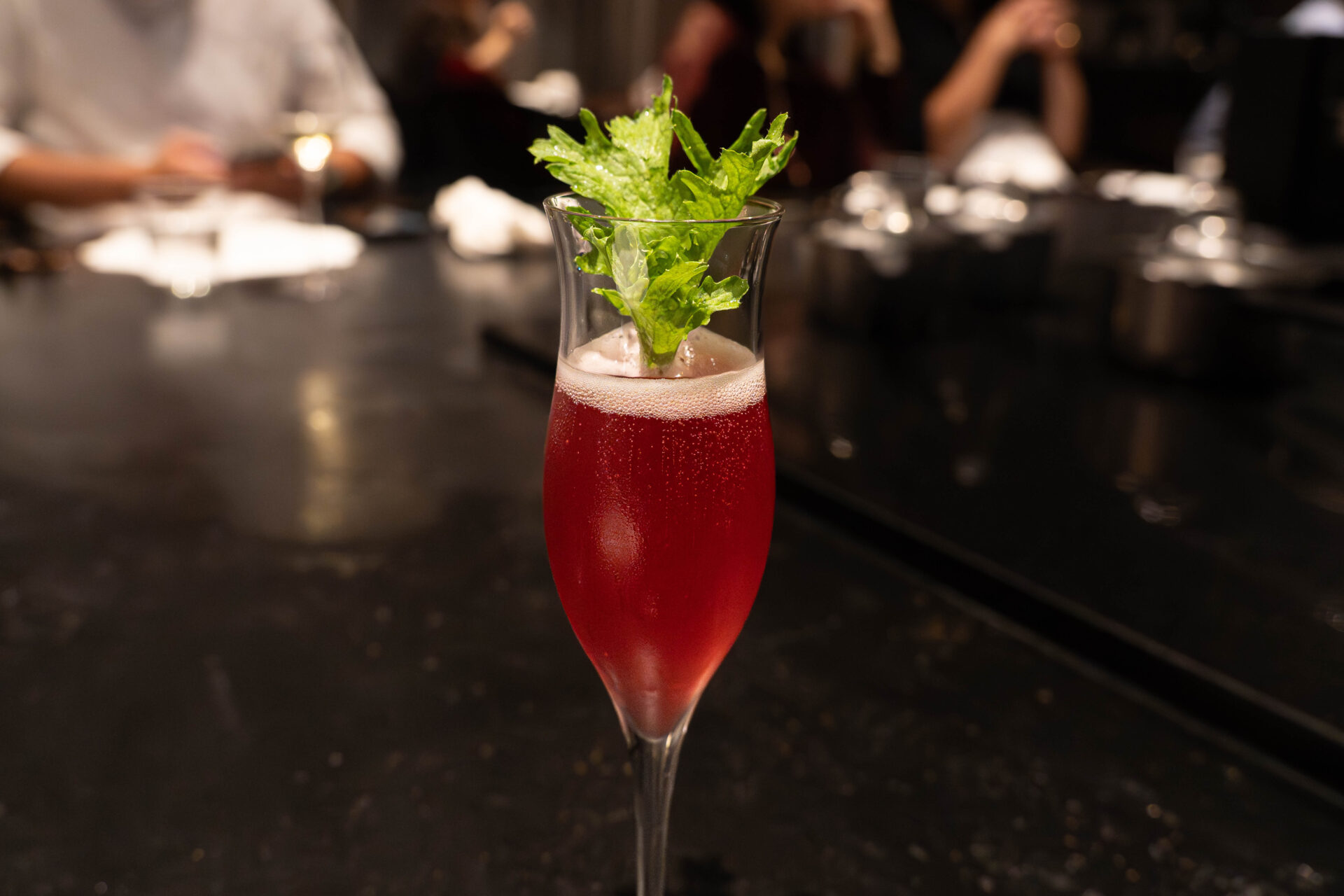
Bread
Served warm in a soft cloth bag were two kinds of bread: one a fluffy steamed bun made with sake lees, delicately sweet with subtle umami; the other a toasted rye bread, hearty and aromatic.
Guests could choose between dairy butter or a soy-based alternative, both aligning with Florilège’s ethos of sustainability and inclusivity. The breads provided a comforting rhythm between courses, grounding the experience with familiar warmth.
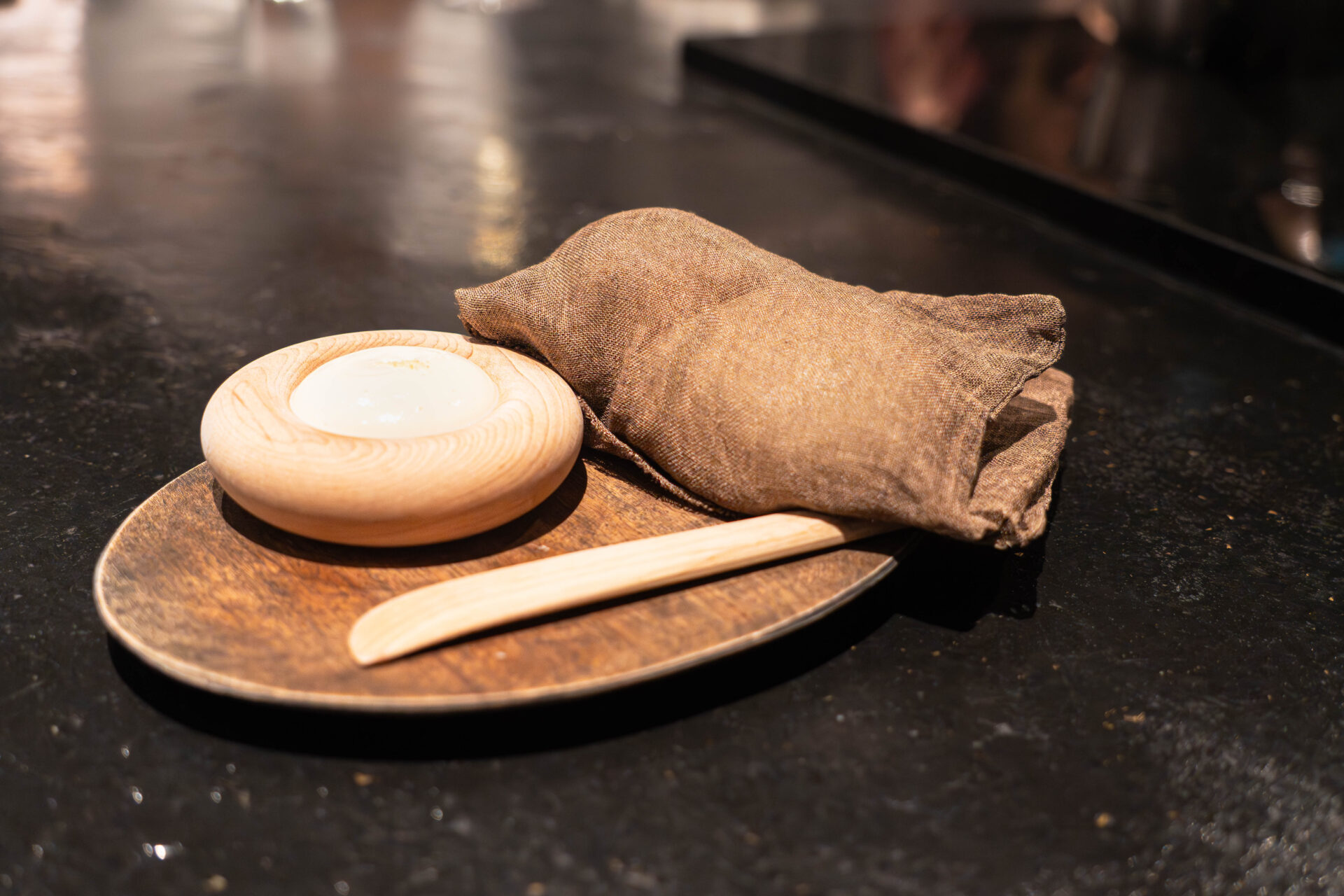
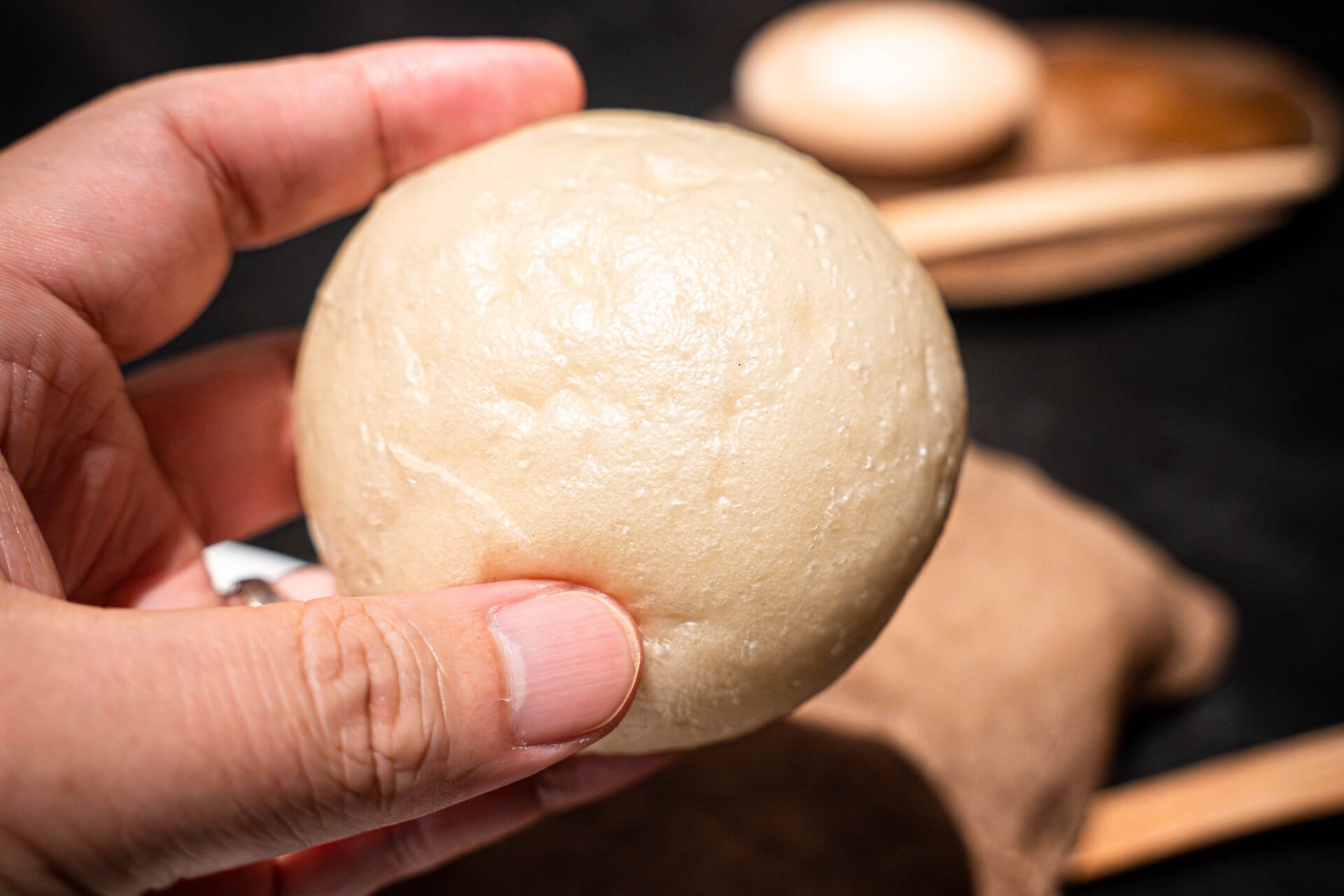
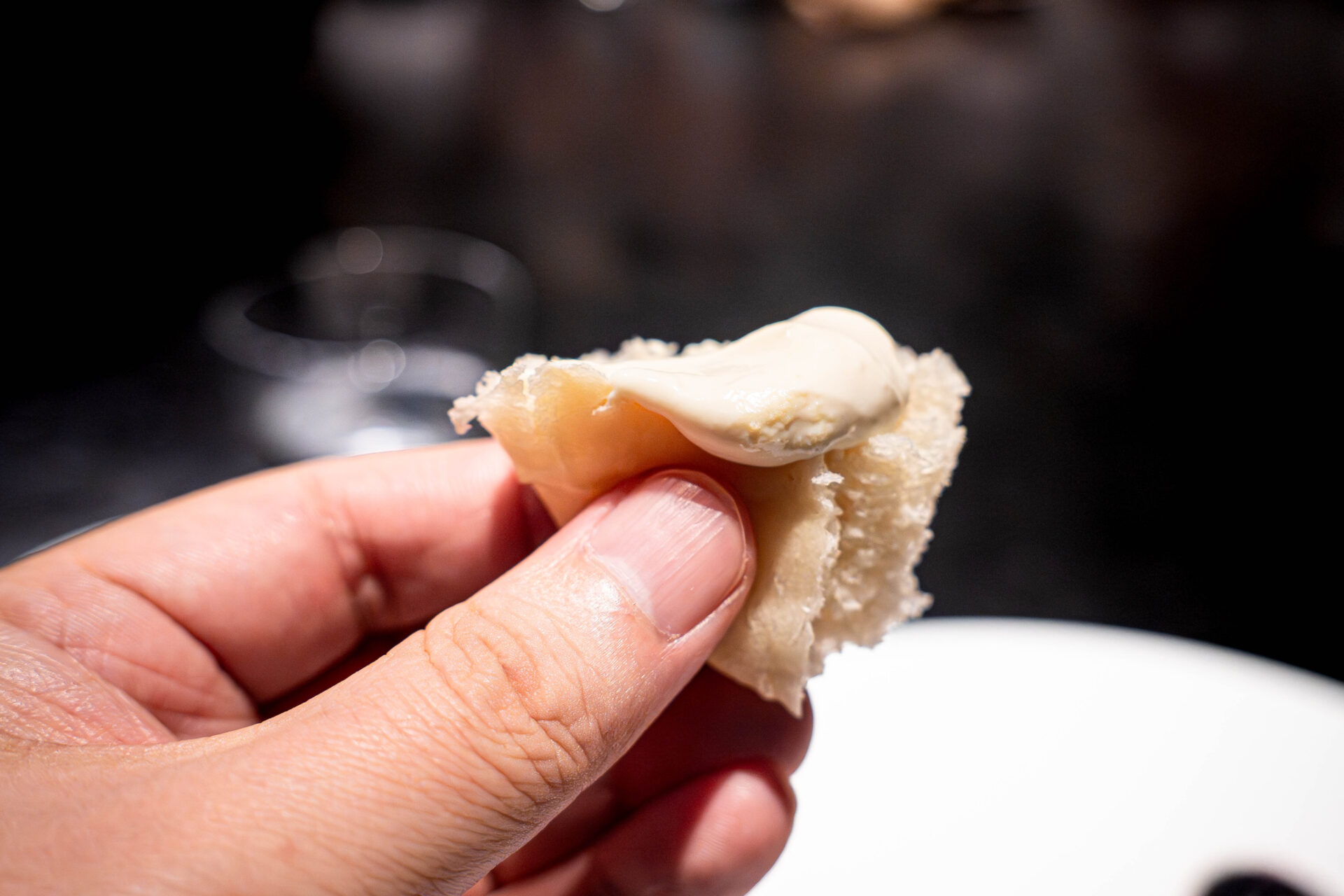
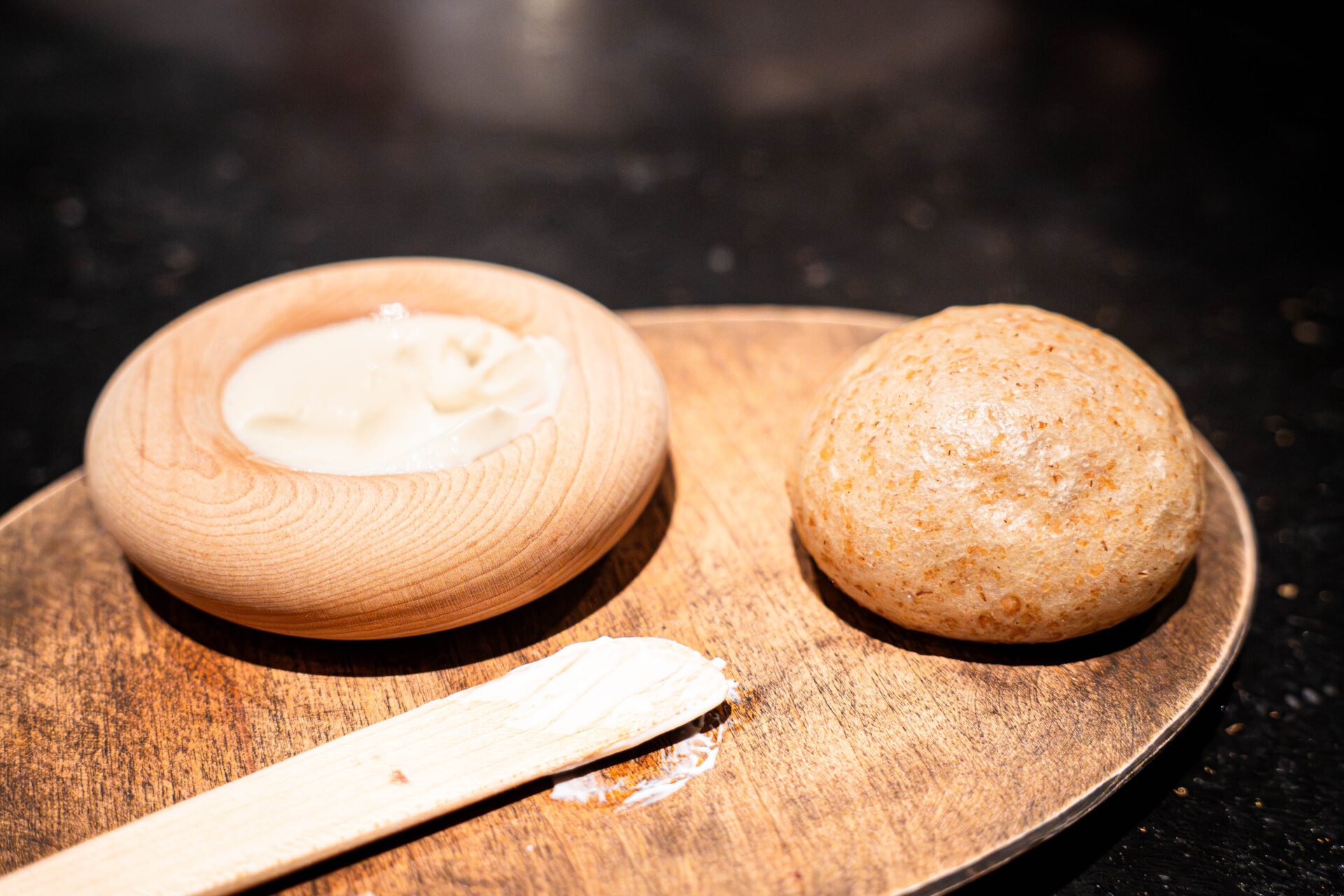
Celery Root and Pear “Cheesecake”
This dish takes the form of a cheesecake but reimagined through Florilège’s lens of creativity. Thin layers of celeriac and pear are stacked like a mille-feuille, forming the base. On top are delicate slices of squid and celery, finished with freshly shaved white truffle, creating an interplay of aroma and texture that blurs the line between savory and sweet.
The sauce combines mascarpone cheese with calamansi vinegar, balancing creaminess and acidity in perfect harmony. The natural sweetness of the root vegetables and fruit, paired with the oceanic notes of squid and the earthy fragrance of truffle, creates a dish that feels at once playful and sophisticated.
Paired with a fermented green apple drink designed to evoke the brightness of white wine, this course captures a delicate synergy. The infusion of lemongrass, lemon verbena, and mint adds herbal freshness, enhancing the creamy, aromatic tones of the dish without overpowering them.
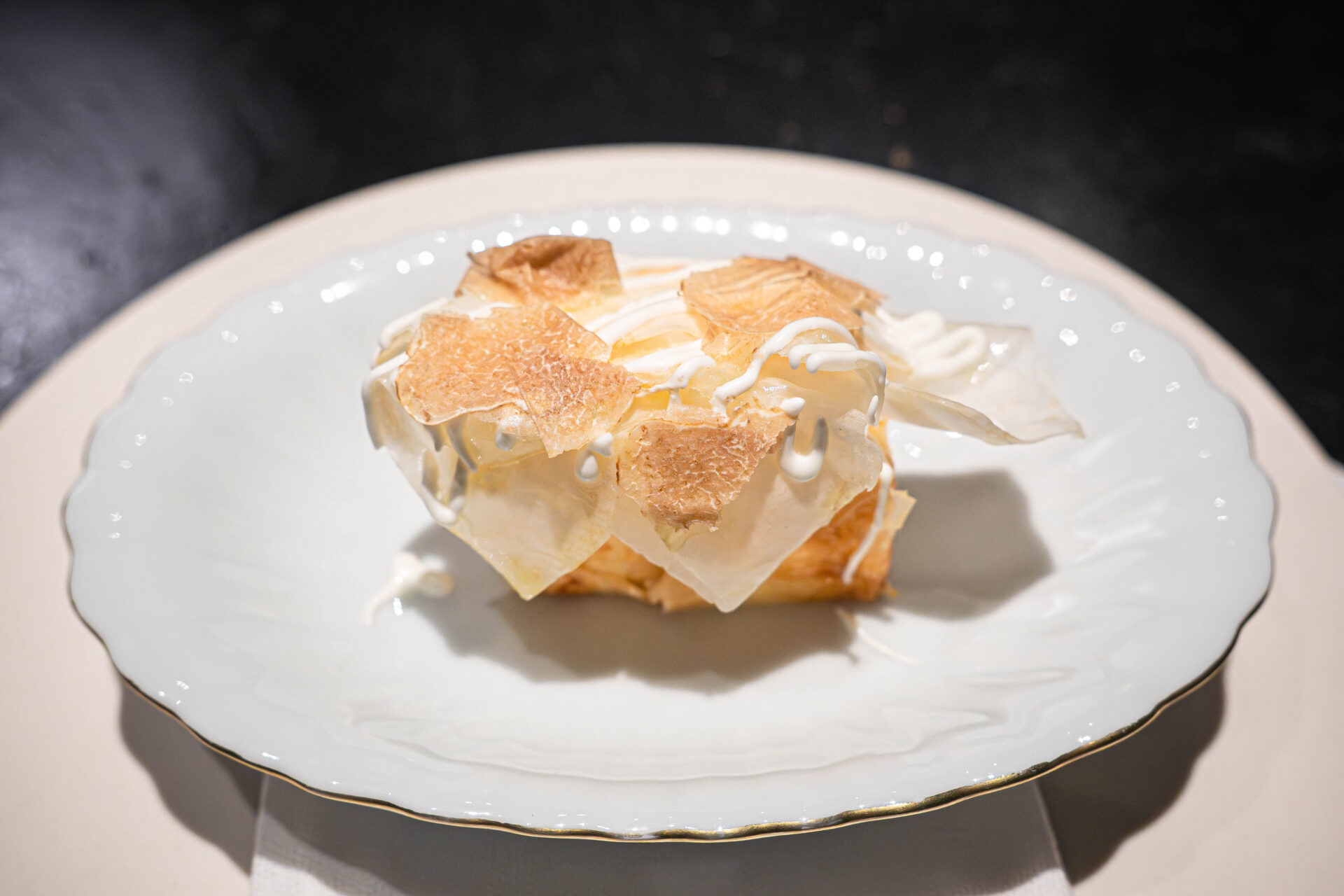
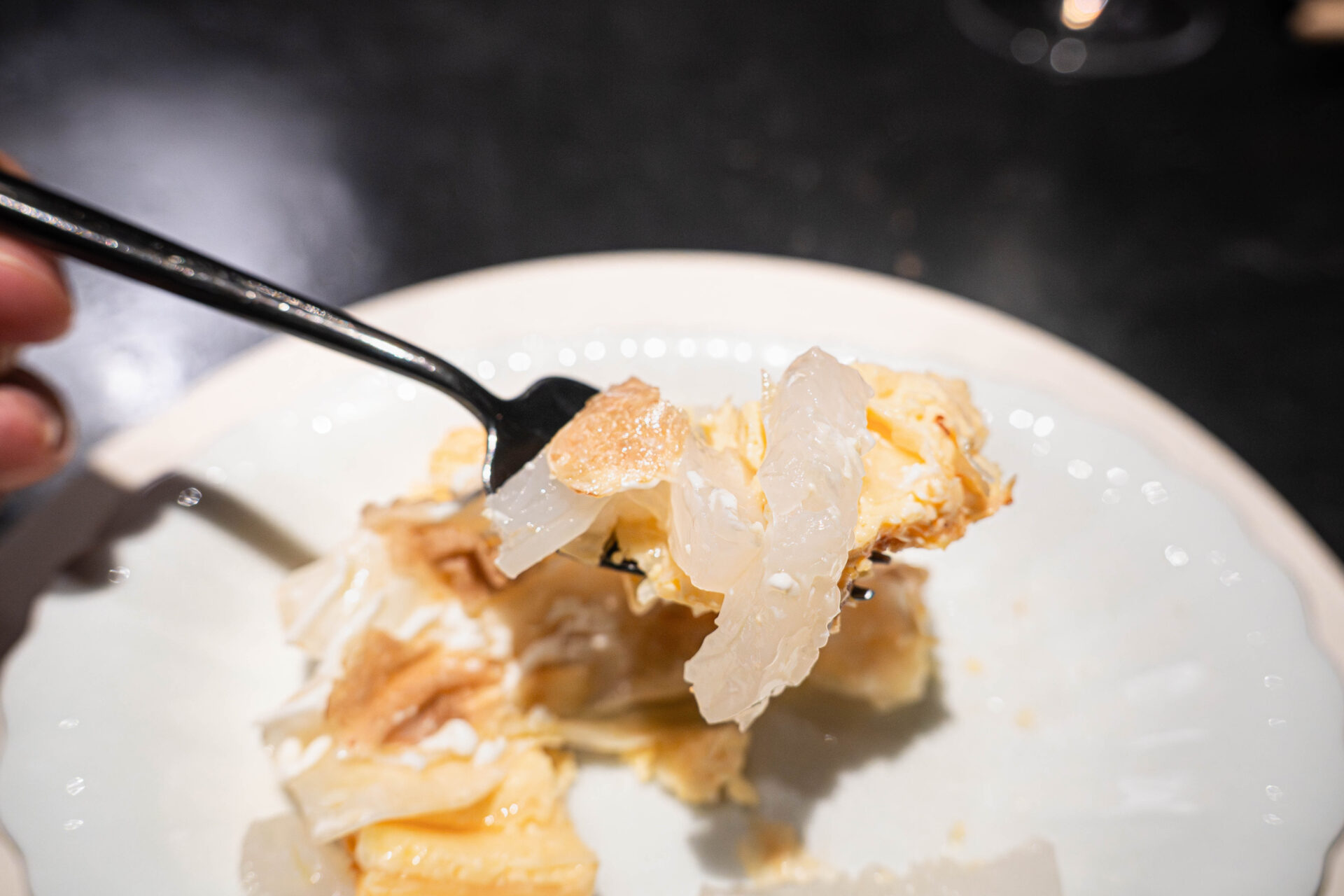
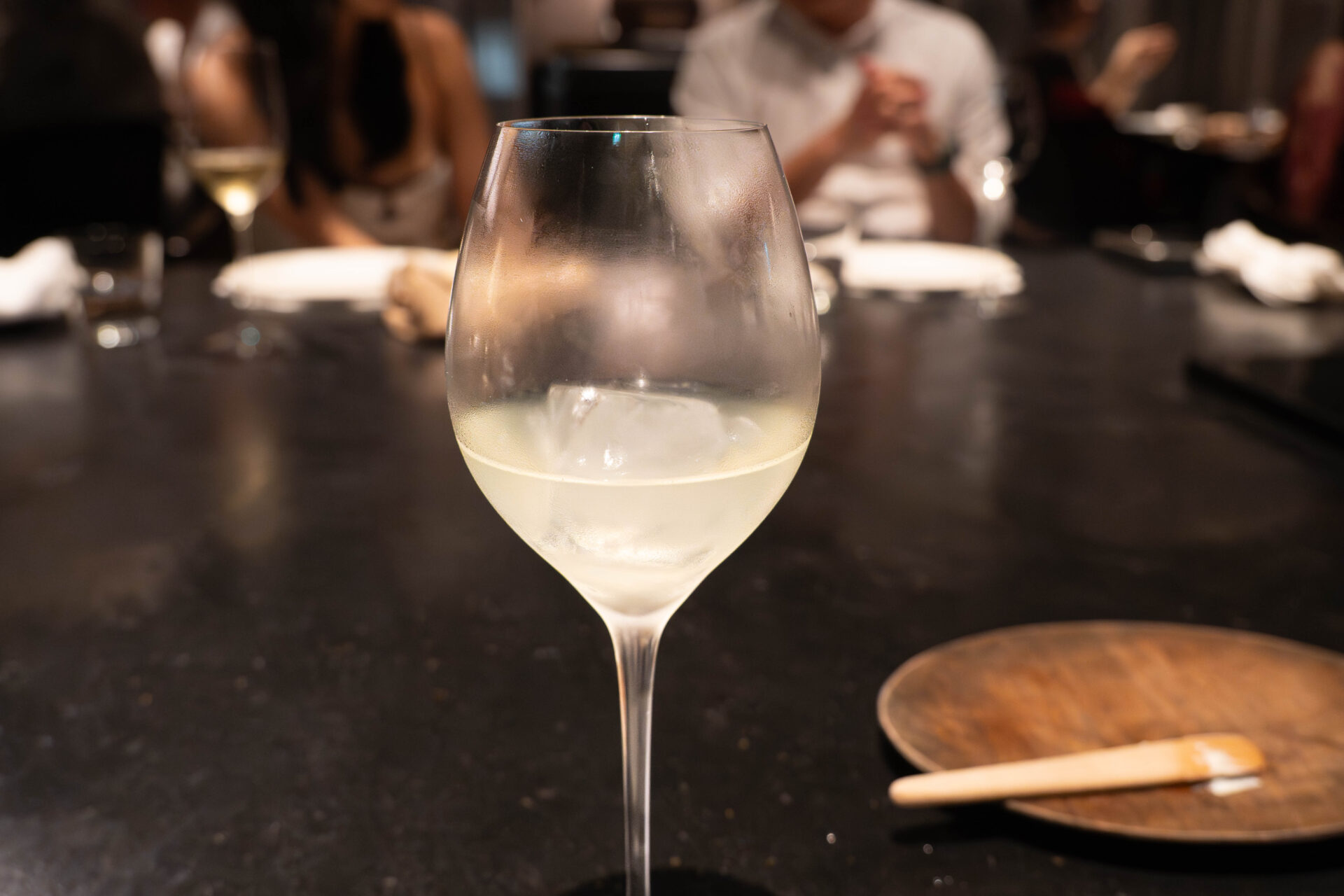
Pumpkin and Maitake Soup
At the center of the bowl rests a beautifully browned pumpkin gnocchi, its sweetness accentuated by the gentle char of the pan. Around it, a fragrant maitake mushroom soup is poured, filling the air with a comforting, earthy aroma that embodies the season.
Served on the side is a pumpkin seed mousse, rich and nutty yet light on the palate. When enjoyed together, the gnocchi, soup, and mousse form a symphony of sweetness, umami, and roasted depth — a layered, autumnal expression of warmth and balance.
The accompanying vegetable-based tea offered a roasted, earthy aroma and clean finish, complementing the dish’s natural flavors. This pairing highlighted Florilège’s philosophy of transforming vegetables not just into food, but also into liquid expressions of taste — extending the ingredient’s life and meaning through each sip.
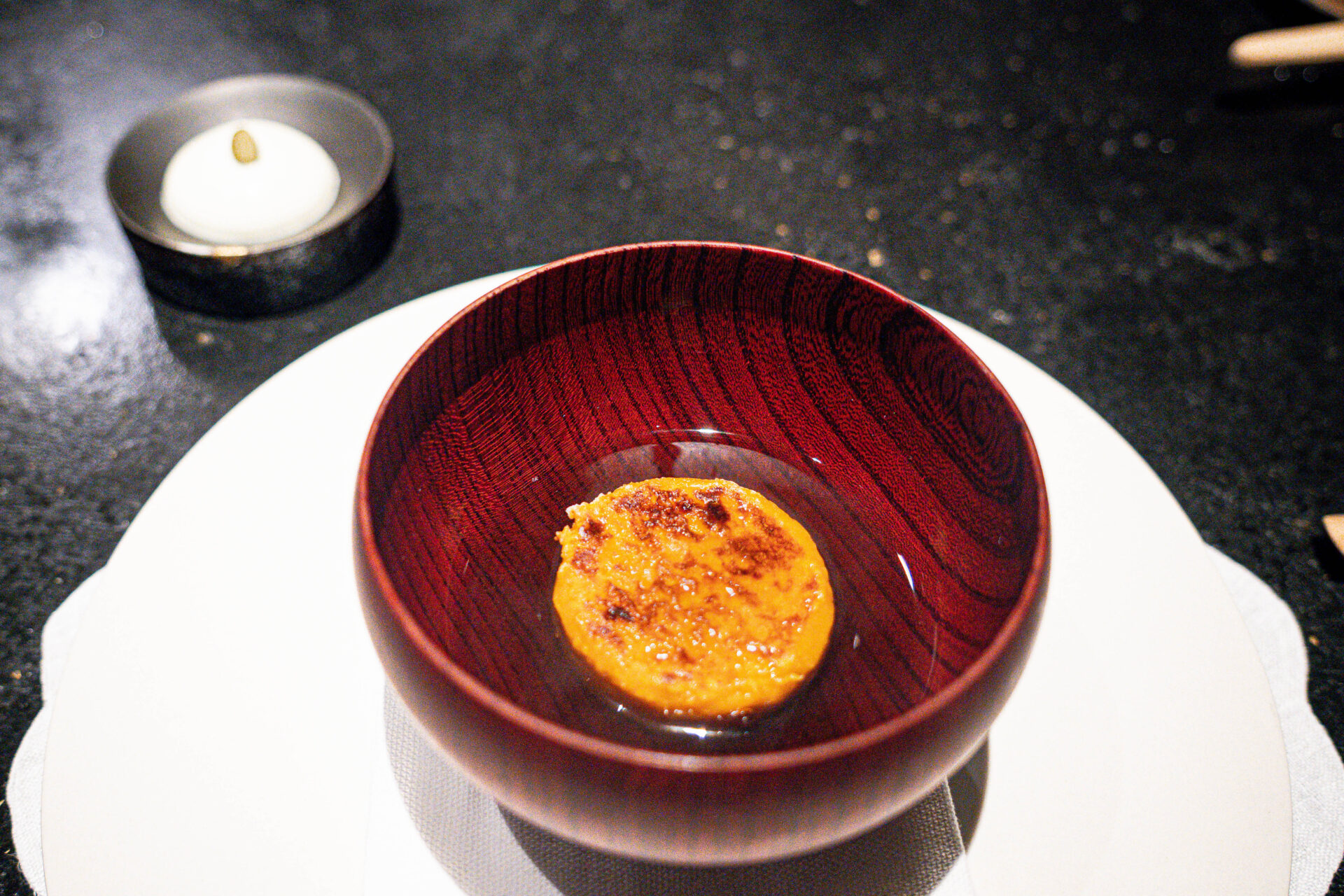
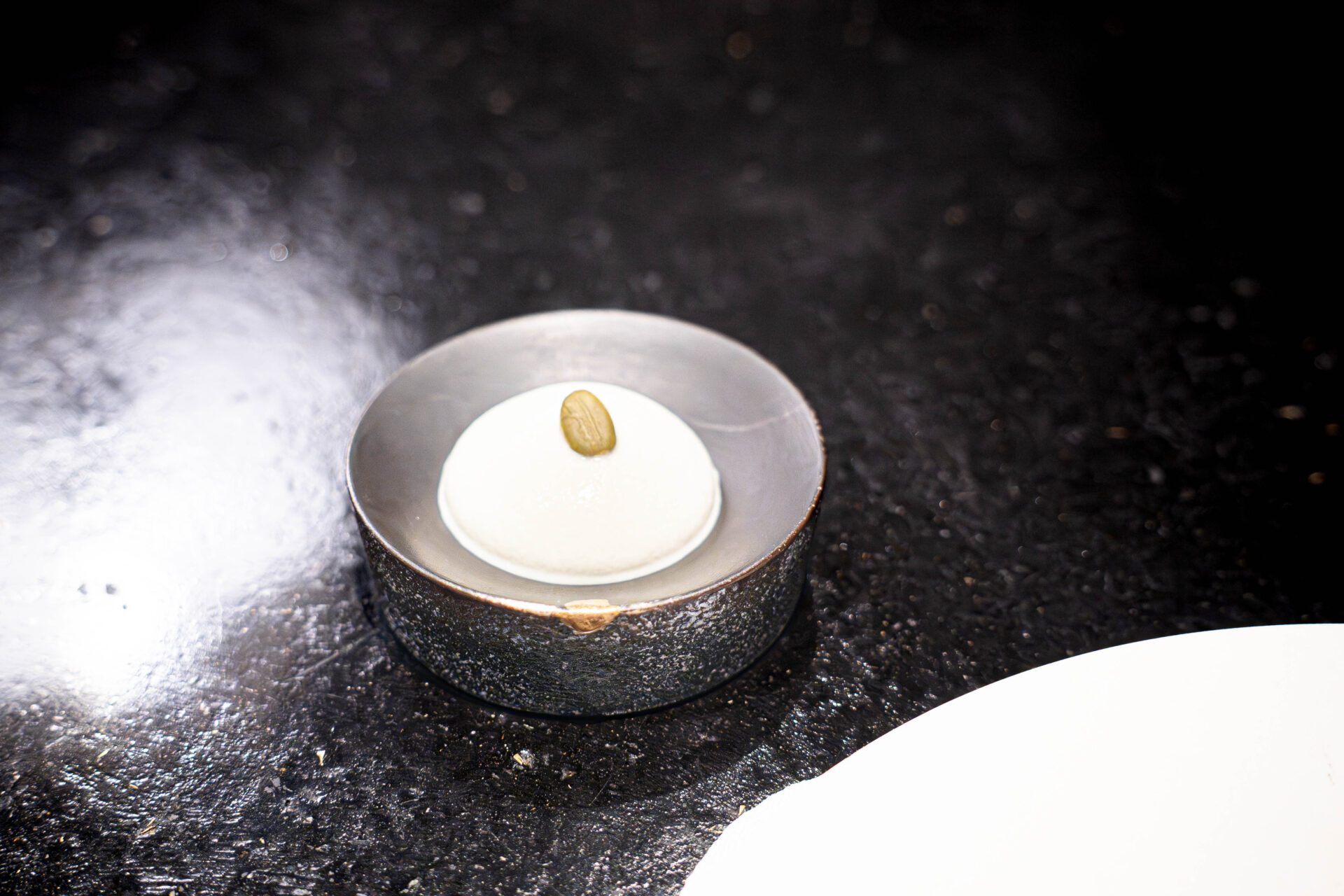
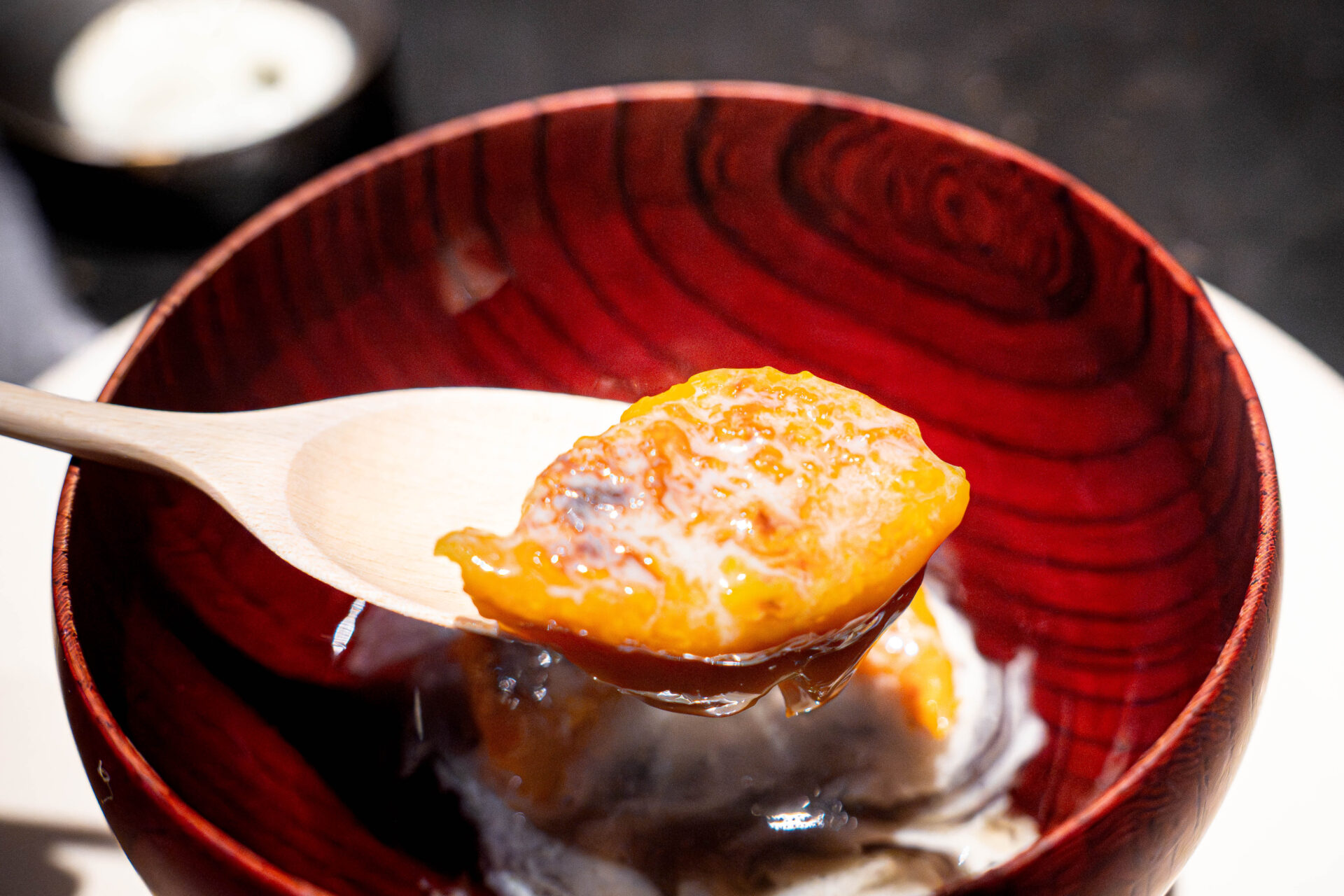
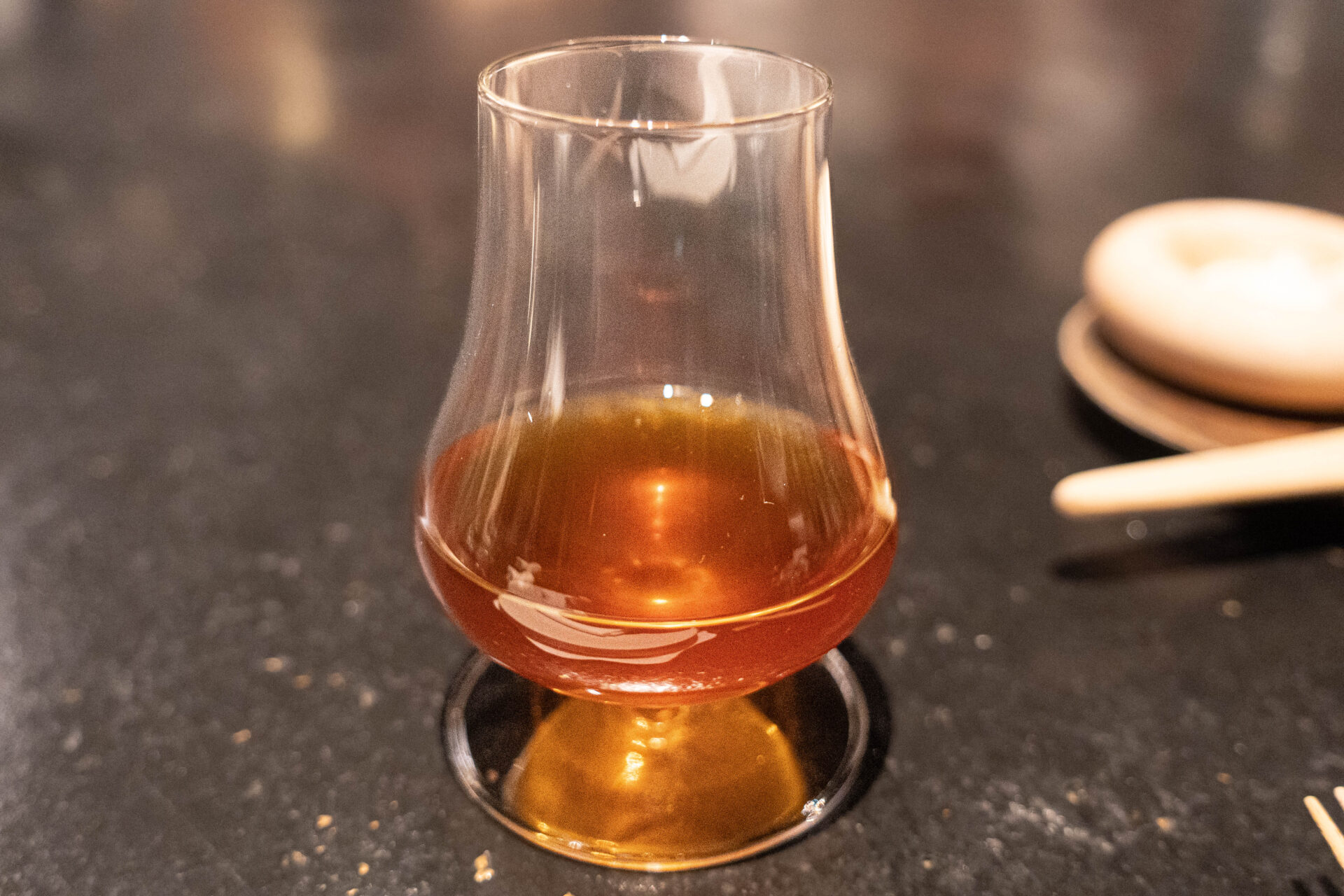
Daikon Wrapped in Pastry
A perfect example of East-meets-West innovation, this dish features daikon radish slow-cooked confit-style, paired with a chewy daikon mochi and wrapped in golden pastry. The crispy exterior and tender interior are dusted with kombu powder and topped with tonburi—known as “field caviar”—for texture and visual contrast.
The accompanying irizake-based sauce, made from a traditional Japanese seasoning of sake and plum, adds depth and umami, while the bright green watercress oil provides color and freshness. A side salad of celery root and herbs with hints of bergamot peel brings lift and complexity to the plate.
The result is a refined harmony of fragrance, temperature, and texture — a fusion of Japanese subtlety and French technique, both grounded and elegant.
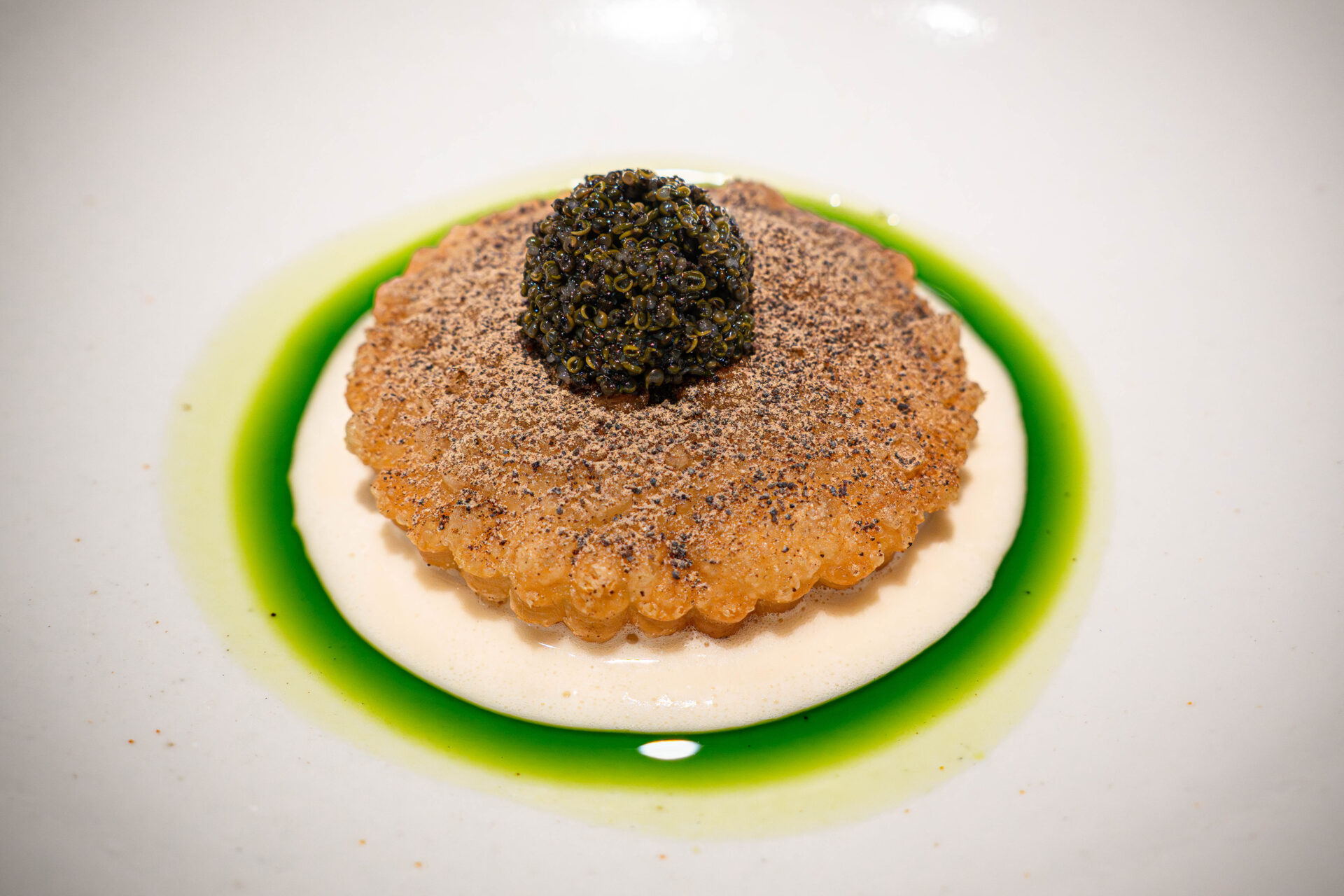
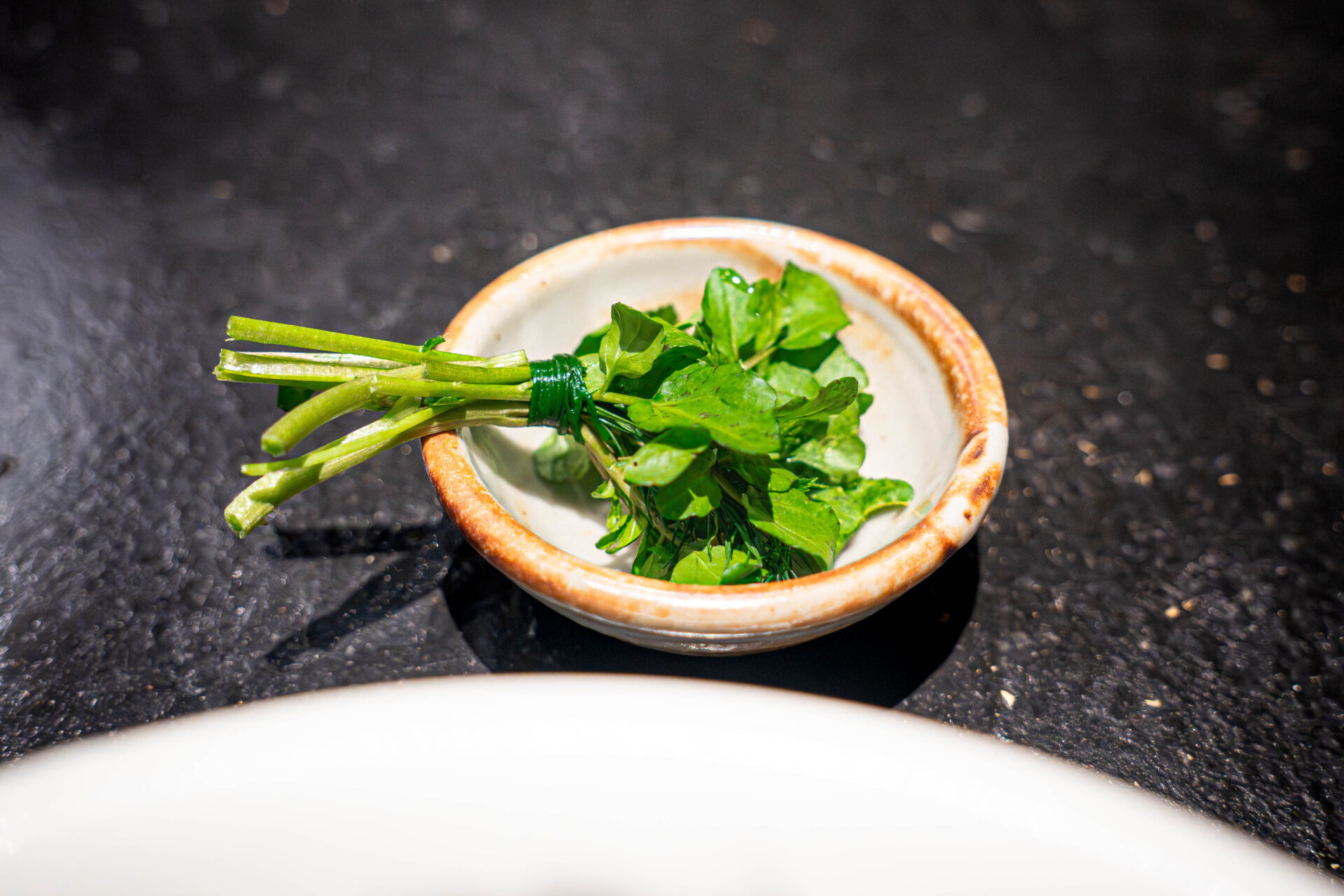
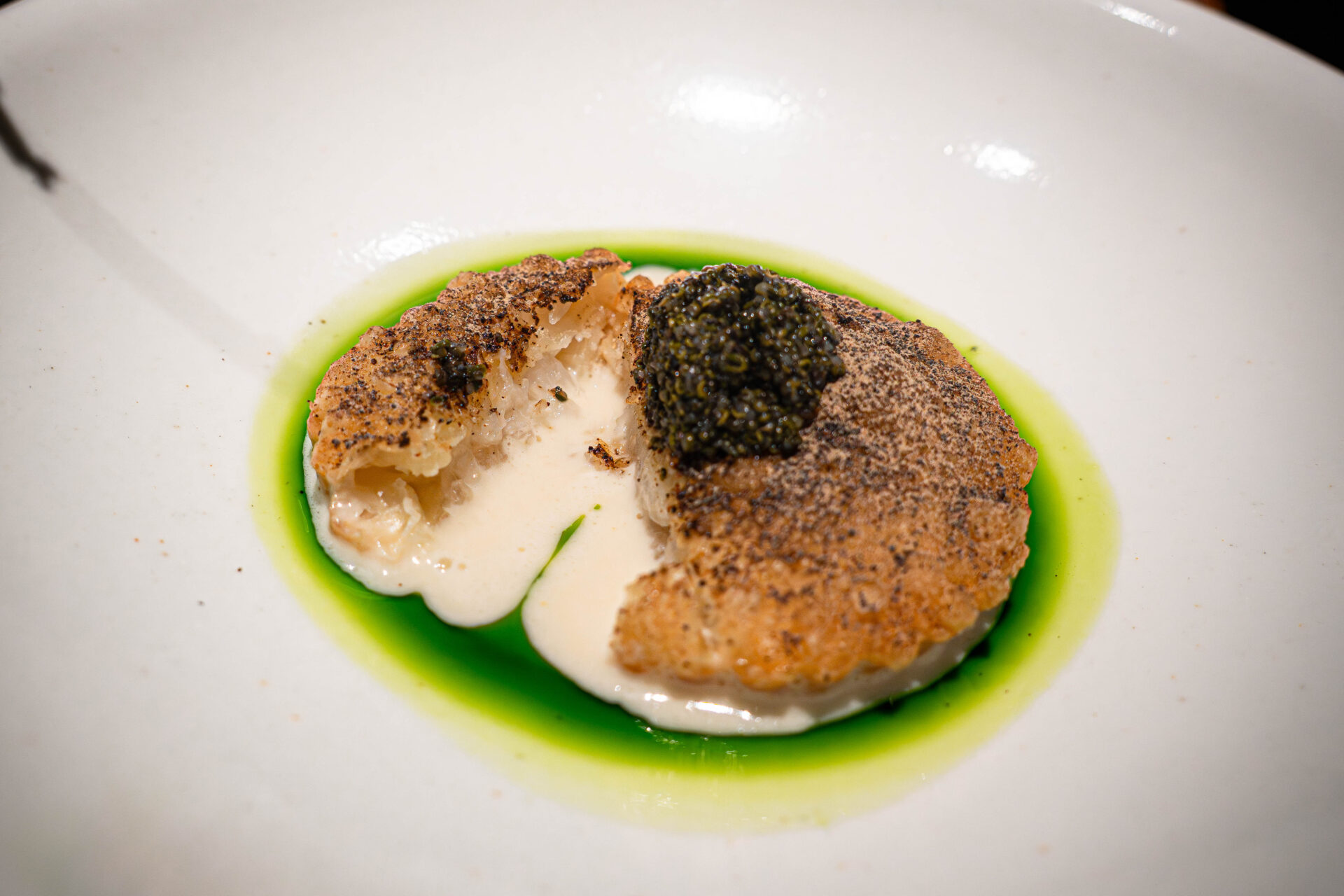
Main Course — Kagoshima Wagyu Beef
The main course featured Kagoshima black wagyu sirloin, presented first as a whole roasted cut before being sliced and plated. The meat was served with a sauce made from onions and aromatic vegetables, its deep sweetness complementing the richness of the beef.
Accompaniments included winter melon, celeriac purée, pickled cucumber, and fresh herbs for contrast. On a separate plate, a refreshing combination of celeriac and tofu topped with passion fruit and a delicate tuile added a bright, tropical accent.
The pairing drink, inspired by red wine, was a non-alcoholic blend infused with soy sauce for umami depth, spices for warmth, and beets for earthy complexity — a remarkable echo of the flavors on the plate.
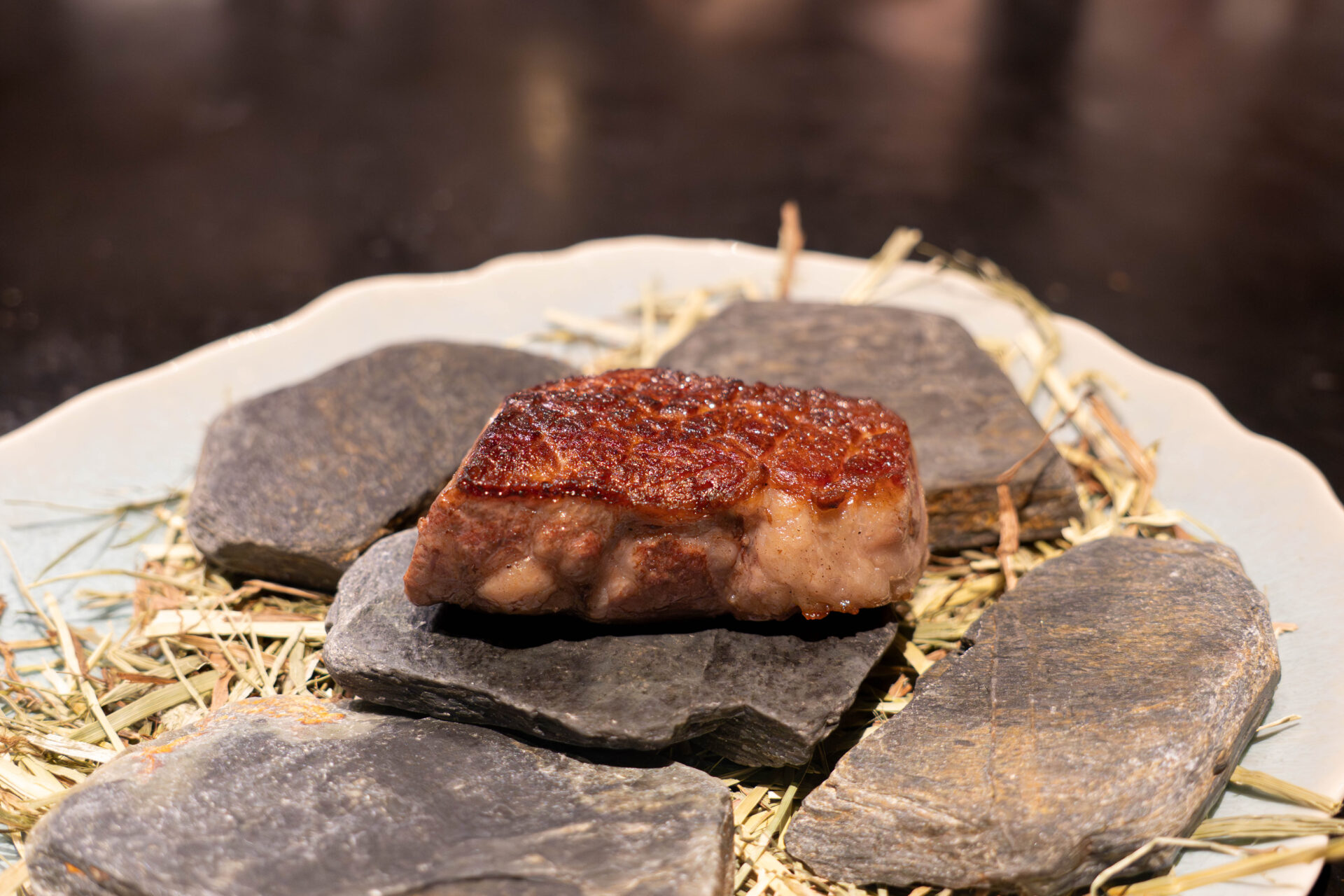
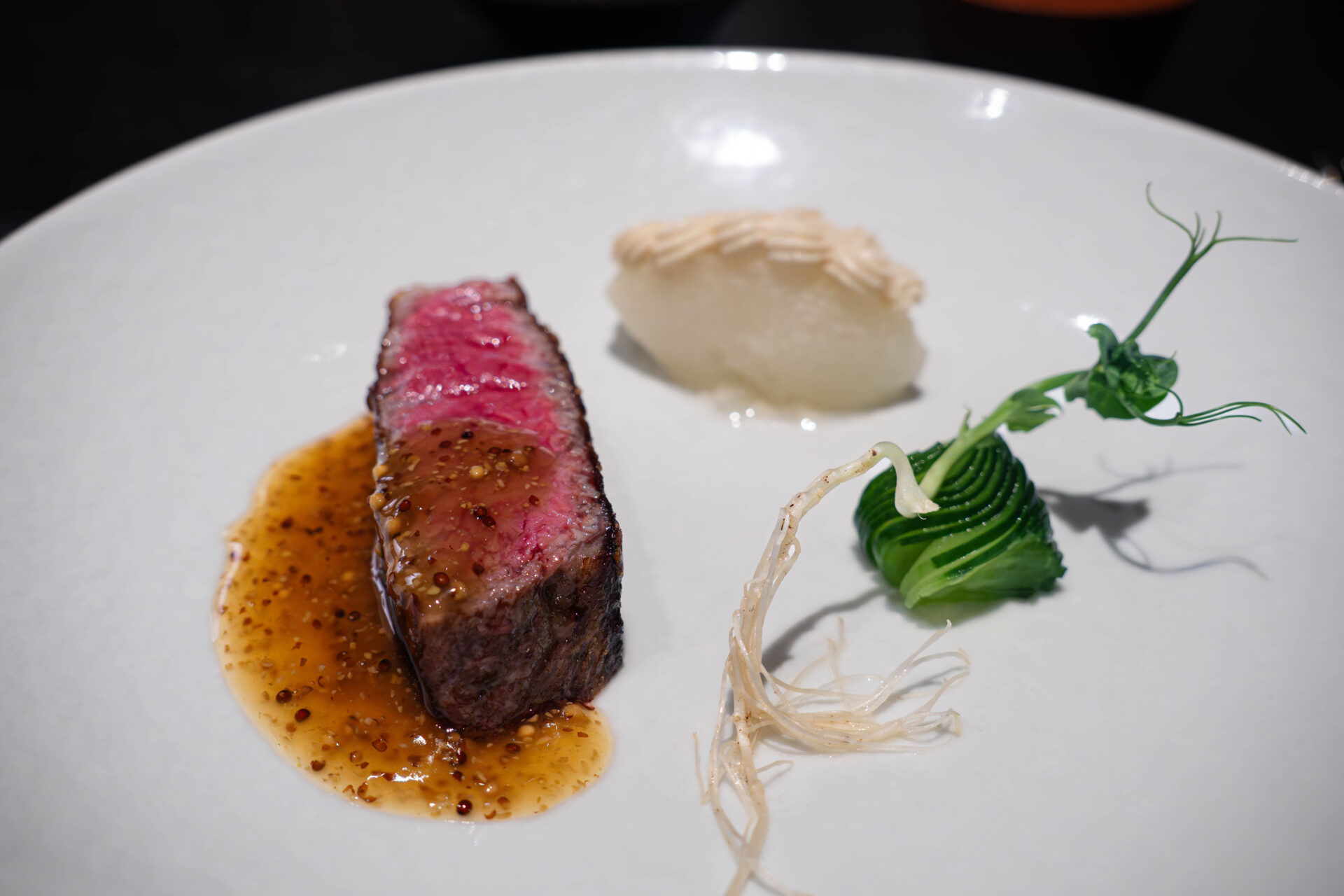
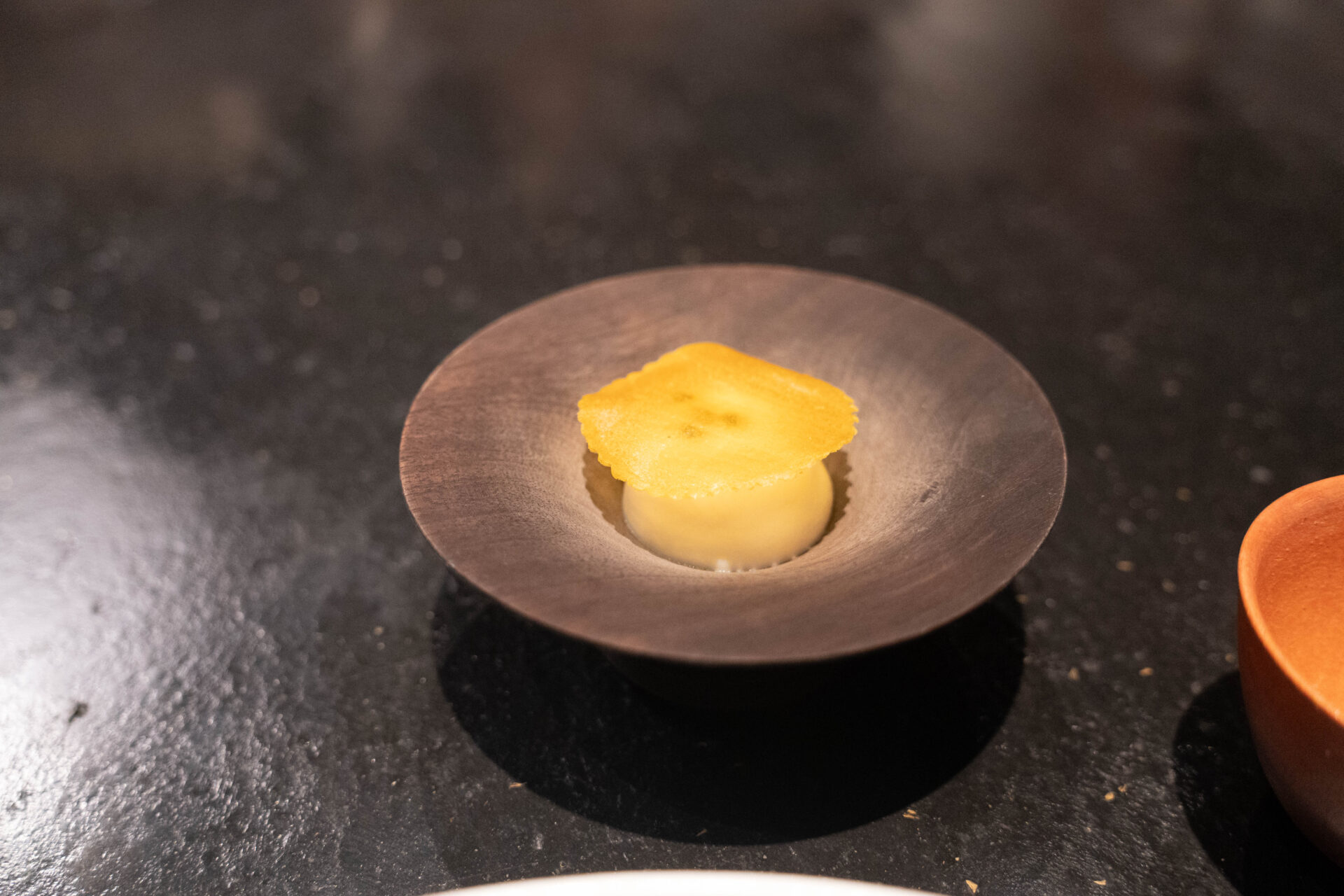
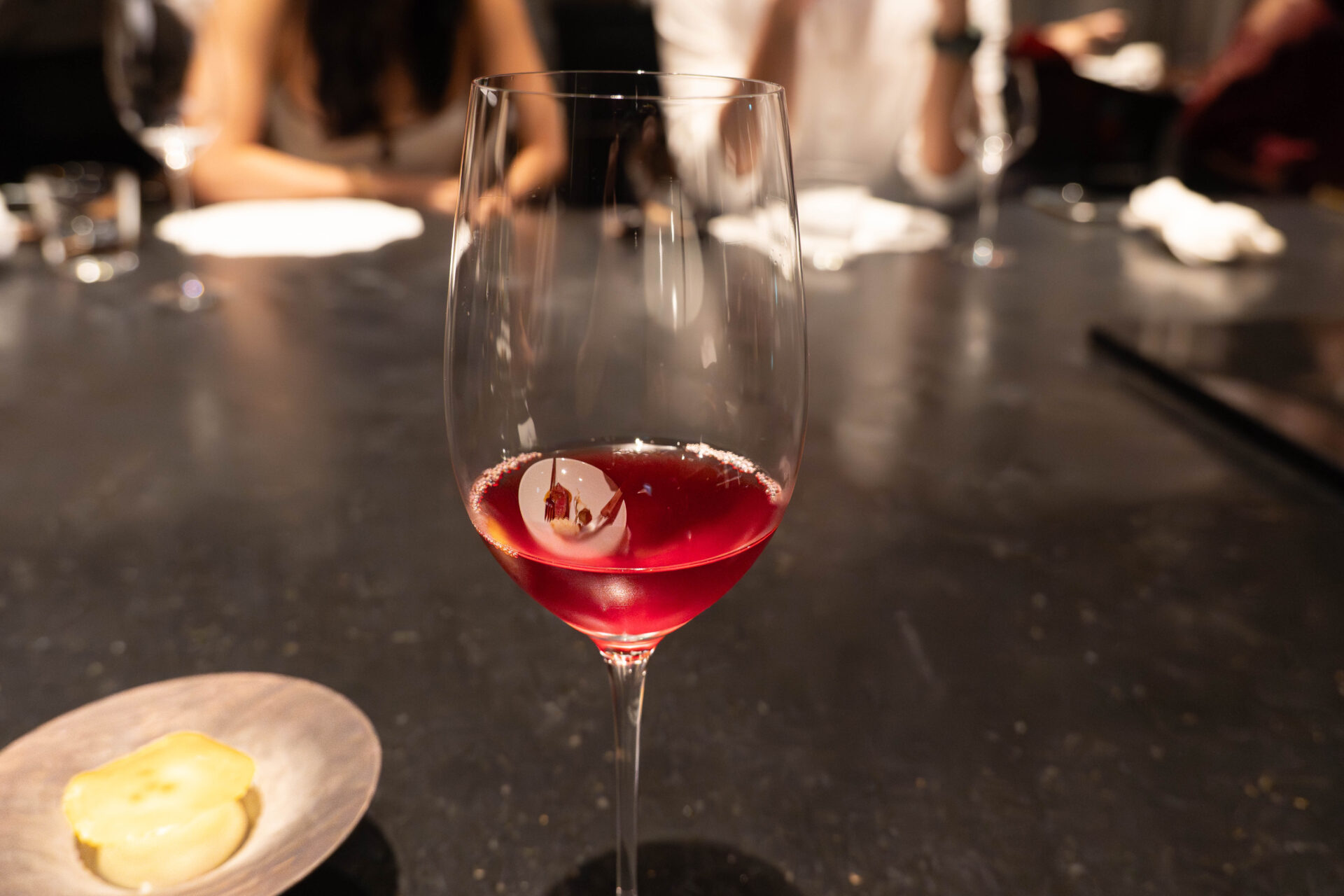
Interestingly, the main dish differed among tables — some guests received duck, others venison. While this could be seen as the chef’s way of distributing the best ingredients of the day or showcasing diversity, it left a sense of curiosity among diners who might have preferred another option. It’s a creative but unconventional approach that reflects Florilège’s evolving dining philosophy.
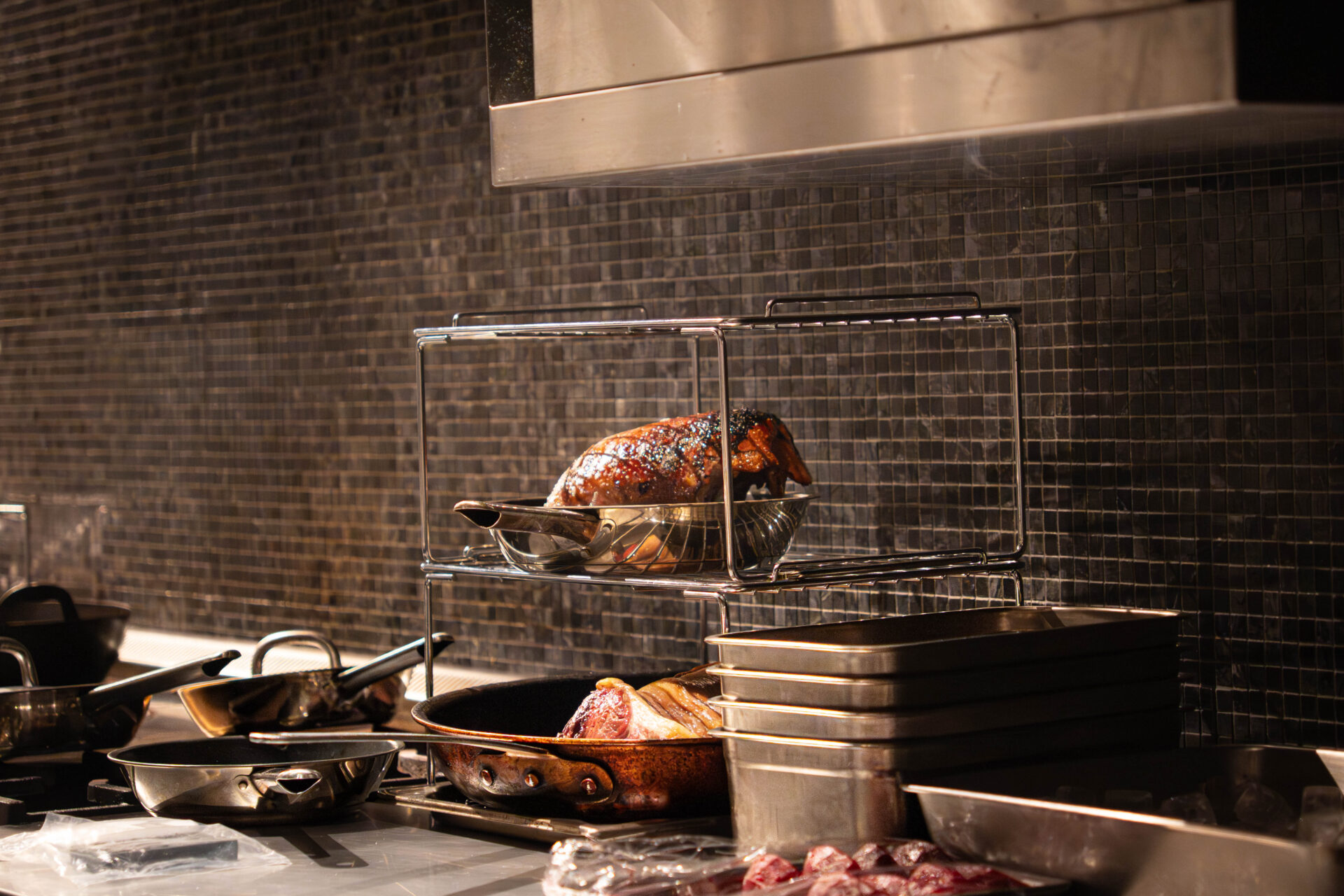
Desserts & Finale
Apple Tatin
The dessert course began with an elegant reinterpretation of a classic tarte Tatin. Caramelized apples were layered over crisp puff pastry, topped with smooth custard cream and a second layer of apple-and-honey cream. Thin slices of frozen apple were delicately arranged on top like shimmering scales, creating a visually stunning finish.
Each bite revealed a perfect balance — the caramel’s bittersweet depth, the apple’s bright acidity, and the cream’s mellow sweetness melding seamlessly. Though minimal in presentation, the dish carried remarkable emotional resonance — both nostalgic and modern in its precision.
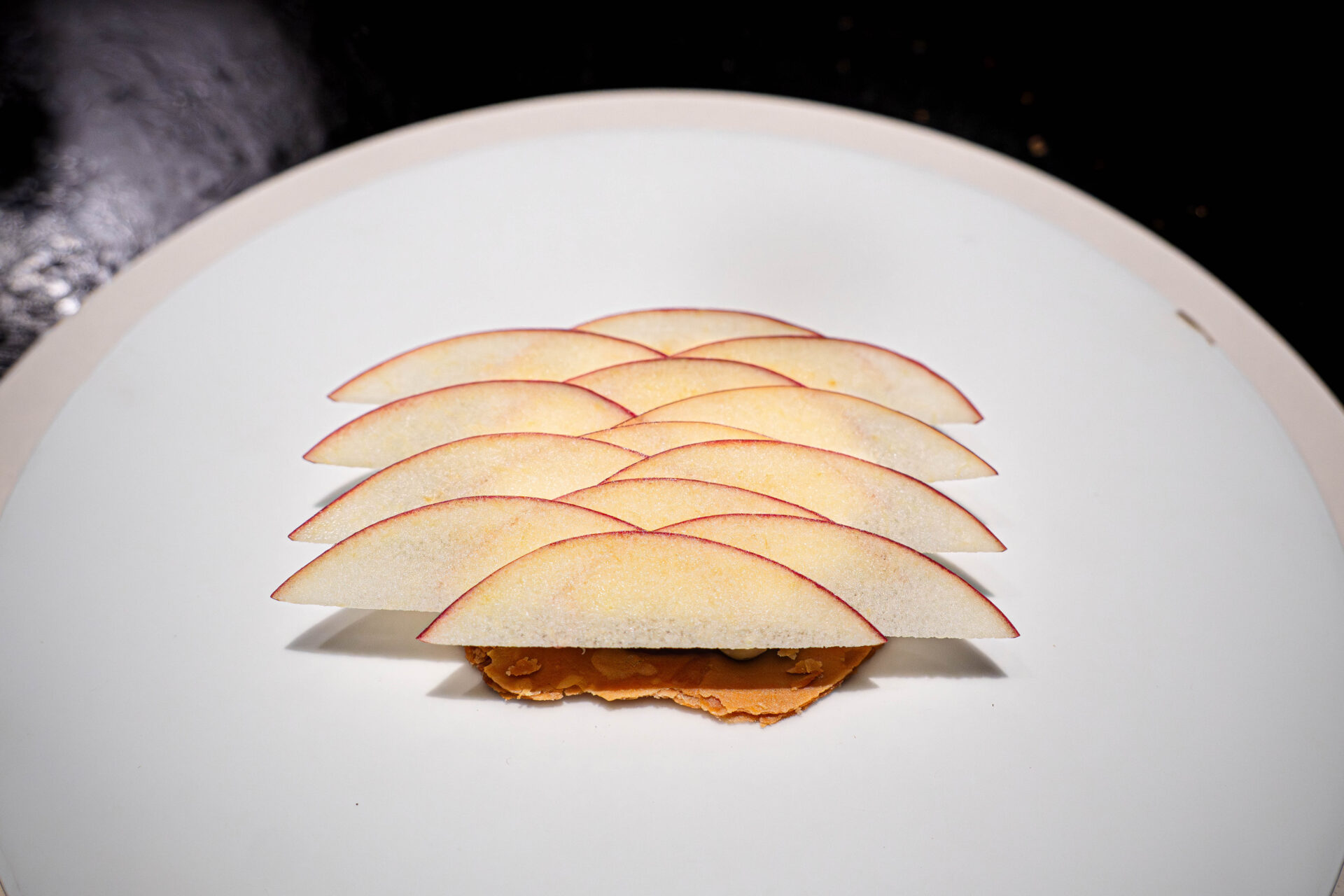
Red Shiso and Cacao Dessert
Wrapped in a vivid red shiso jelly sheet, this dessert was breathtakingly beautiful even before the first bite. Inside lay layers of white chocolate mousse, rhubarb compote, and Amazon cranberries. When cut open, the contrasting colors and aromas burst forth, creating an almost theatrical effect. A drizzle of red shiso sauce tied everything together with herbal freshness and a touch of sophistication.
Elegant yet daring, this dish epitomized Florilège’s style — harmonizing Japanese ingredients with French technique in a way that feels entirely original, evoking both surprise and admiration.
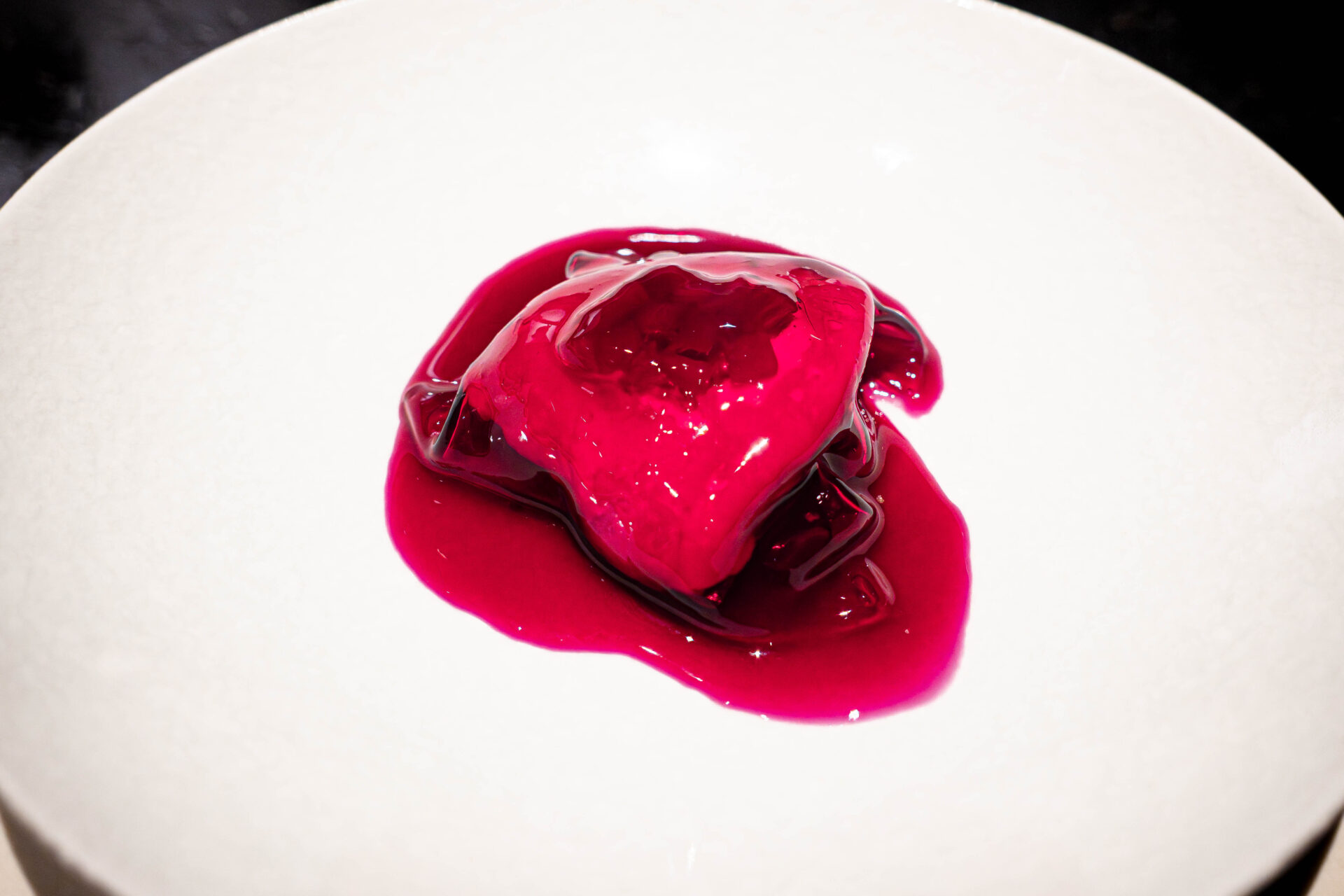
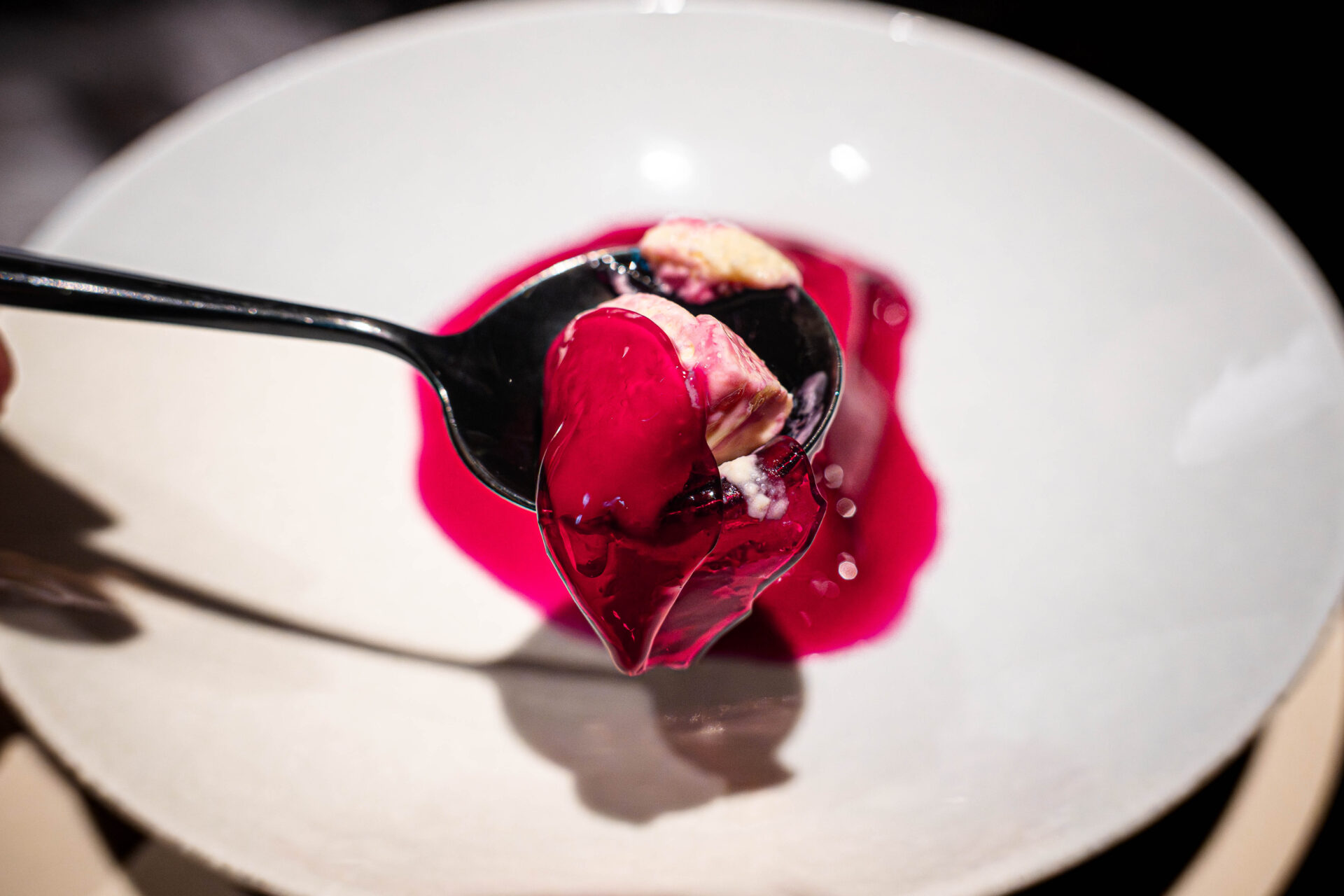
Petit Fours
The petit fours, served at the end, reflected the same quiet refinement that defined the entire meal. Each bite seemed designed to leave a lingering impression rather than a bold finale.
A small piece of kohakutō (traditional Japanese crystal candy) infused with peach invited guests to eat with their hands — delicate and playful. Behind it, financier and husk tomato glacé added richness and charm, while a blueberry and fermented red bean jelly bridged Japanese and Western confectionery traditions with grace.
Every sweet offered serenity and intention — a closing act that embodied Chef Kawate’s sense of “beauty in stillness.” It was an ending not of grandeur, but of reflection.
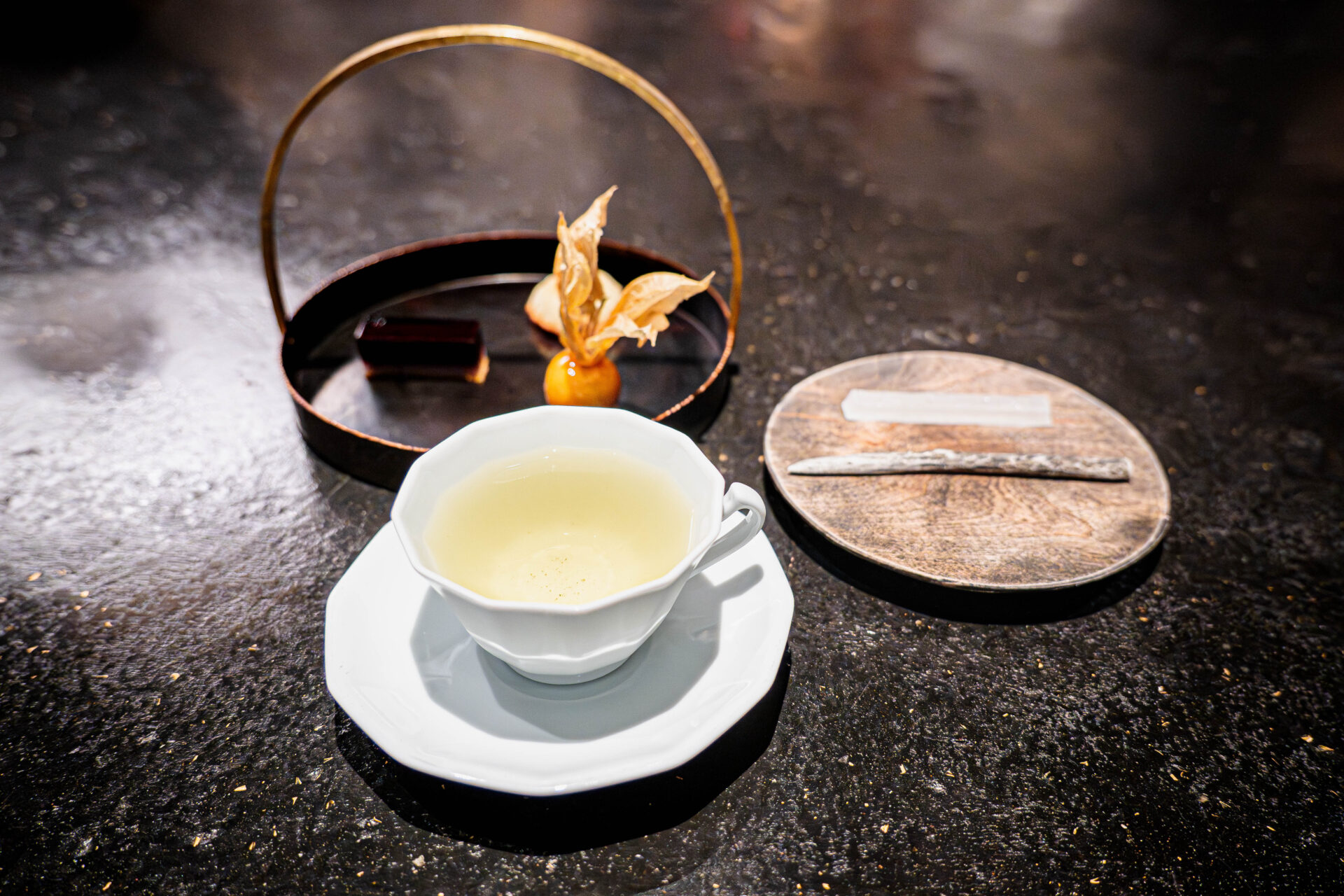
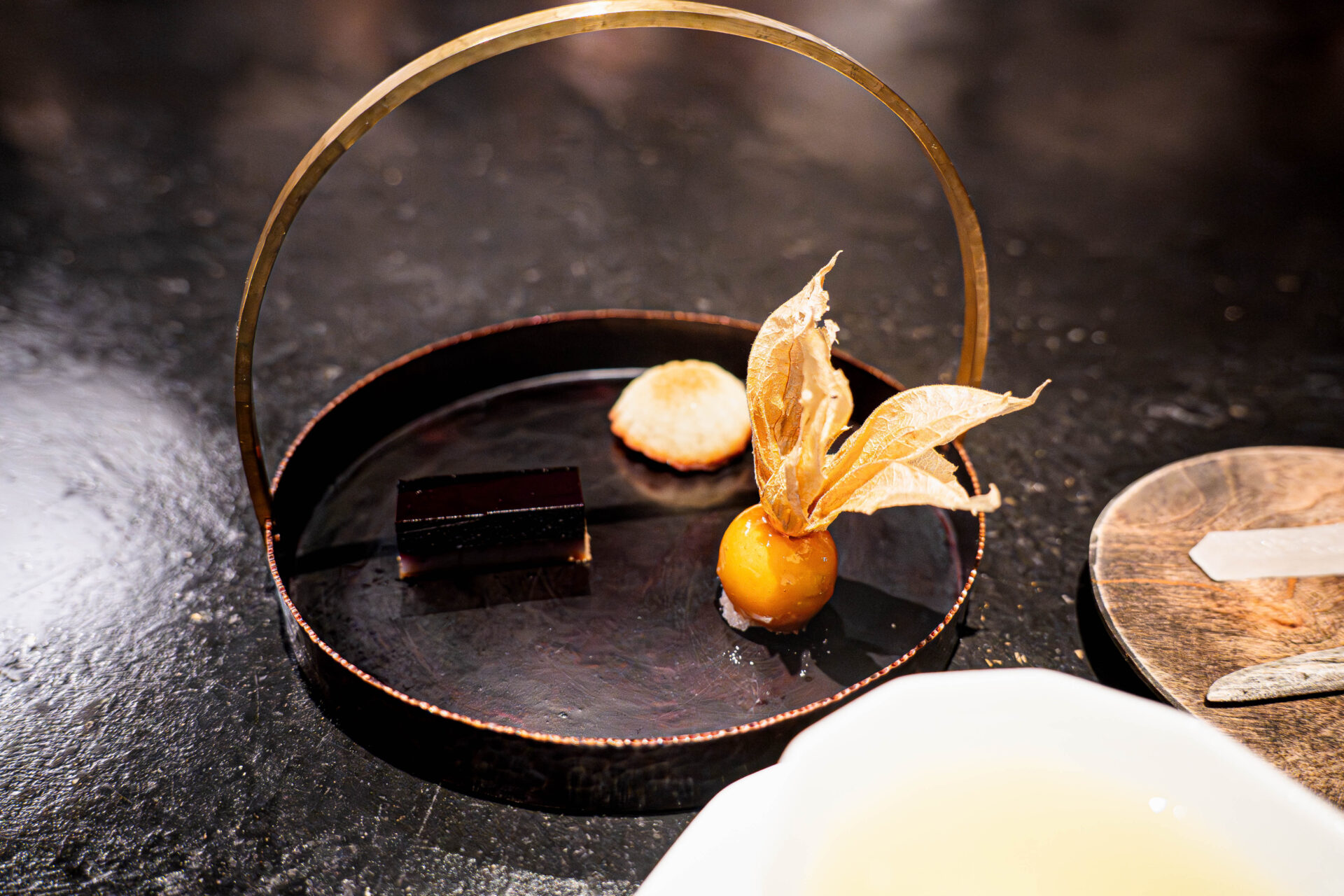
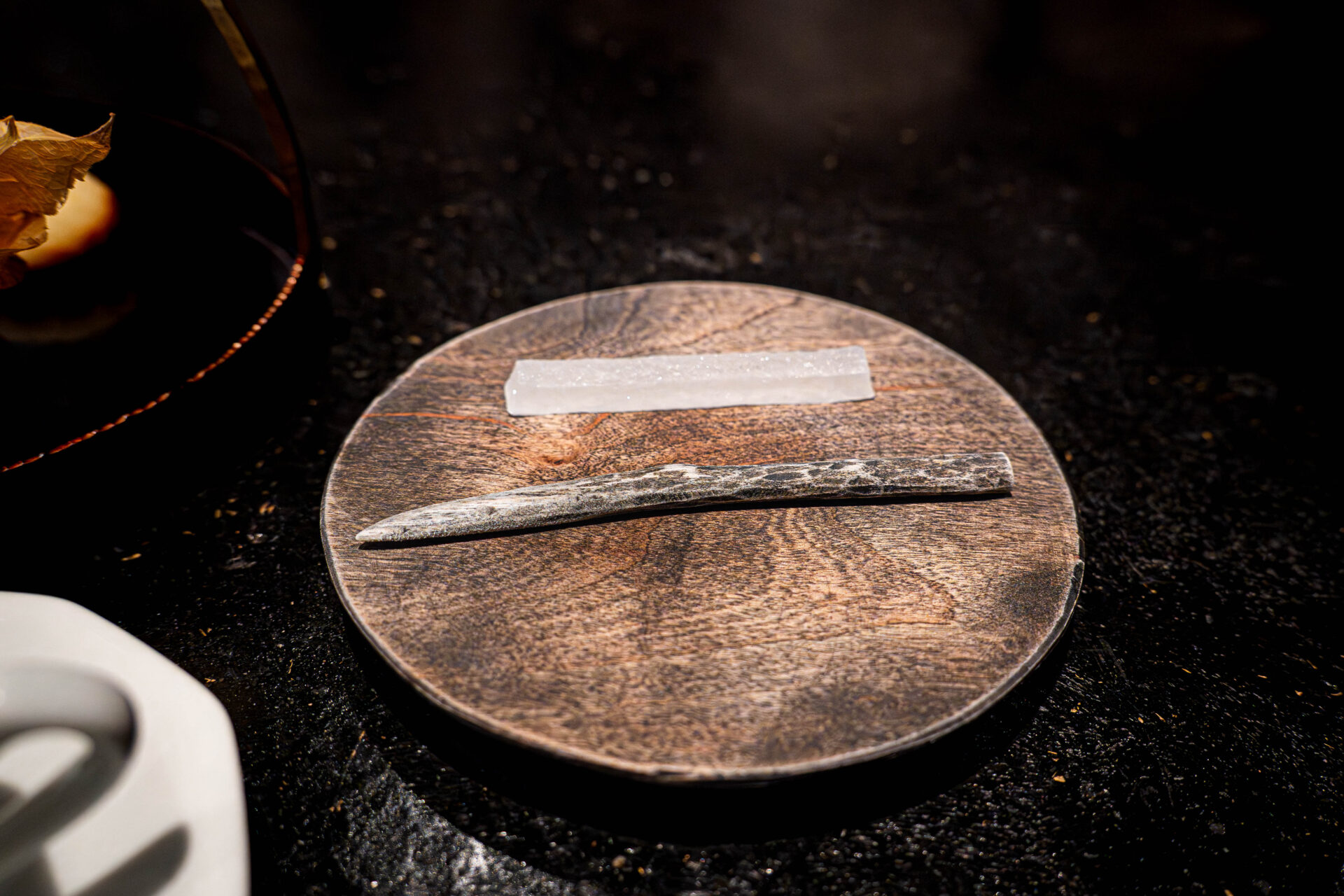
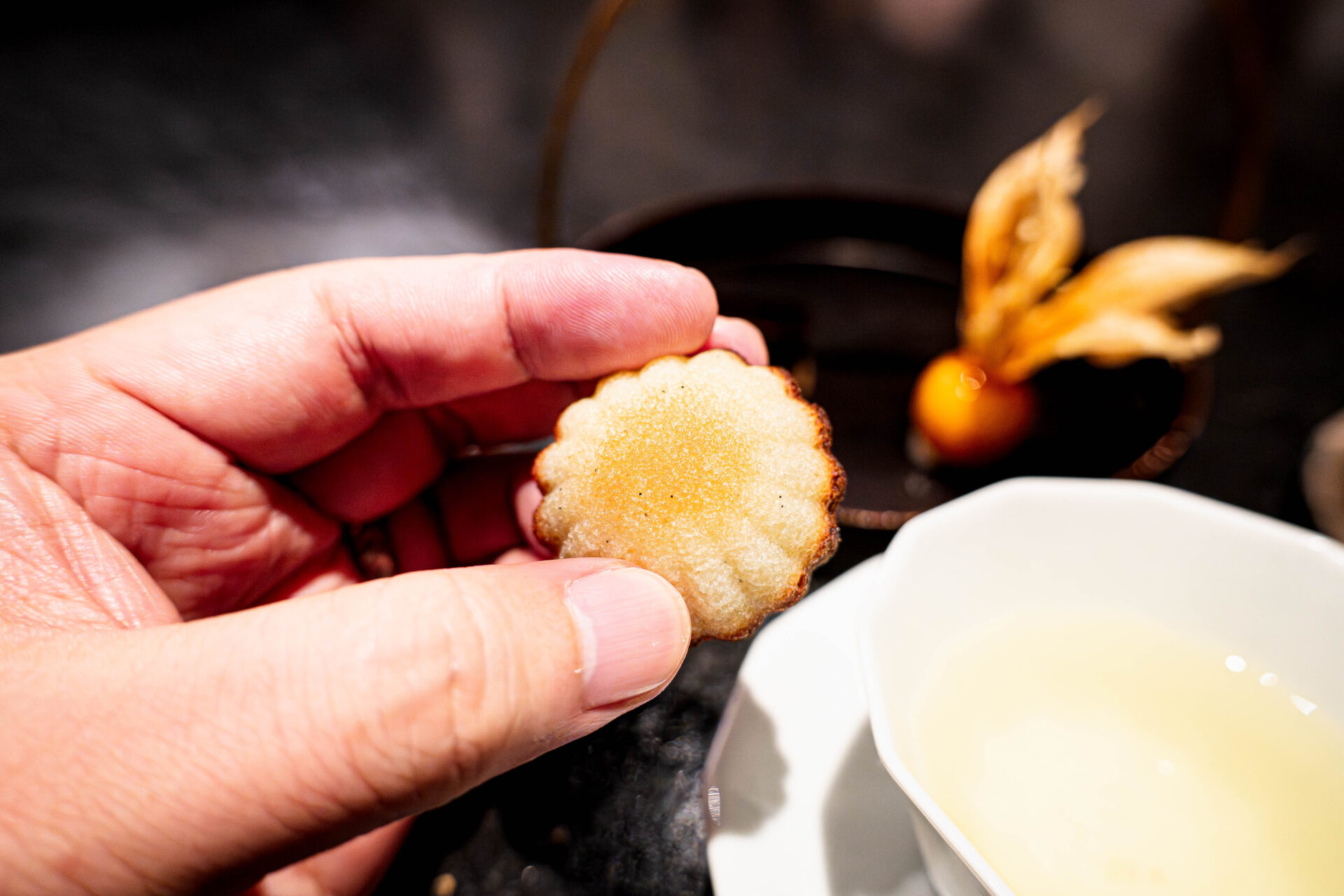
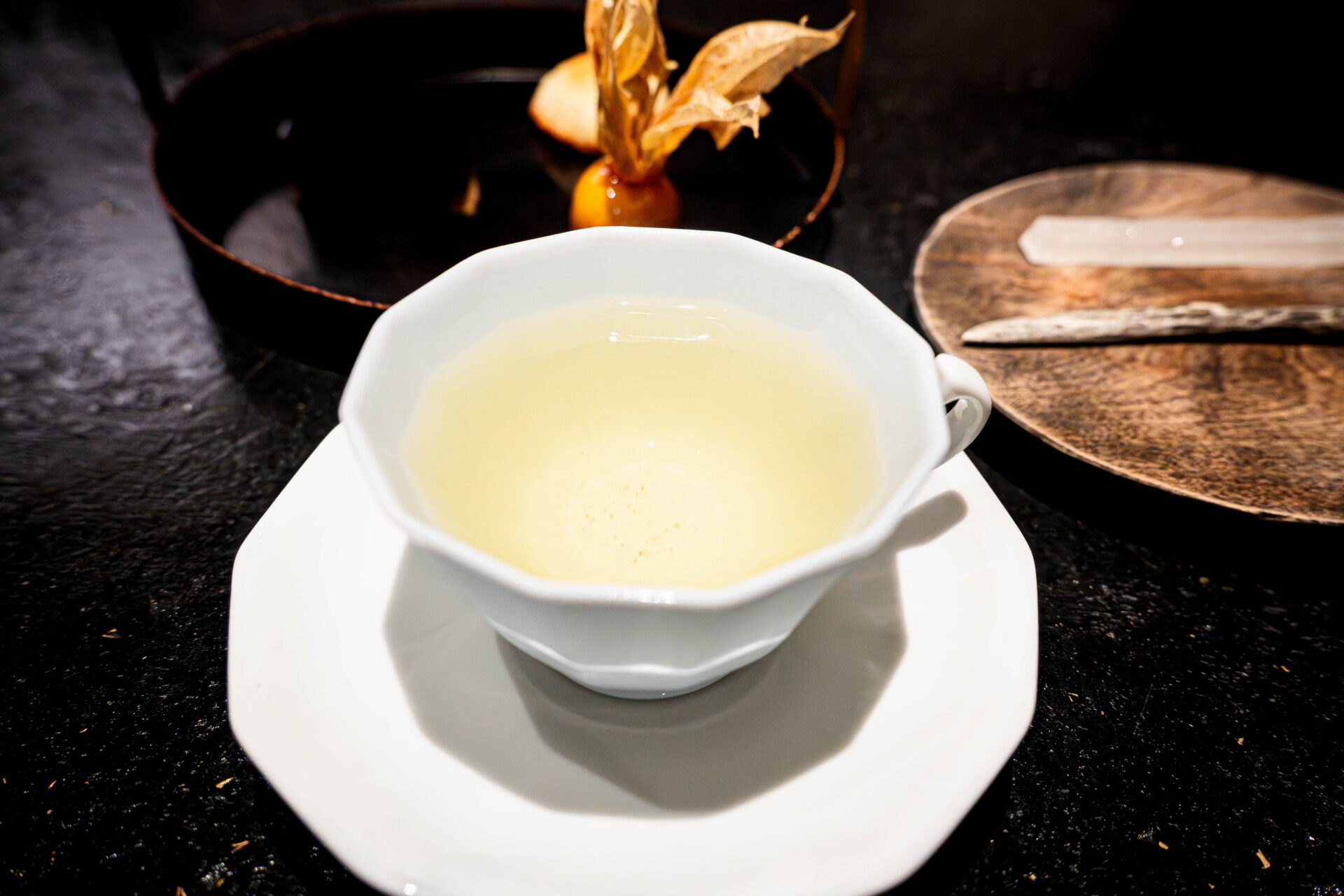
Overall Impressions
The dining experience at Florilège was not merely about consuming food — it was an immersion into philosophy and storytelling through the senses. From the opening consommé to the inventive non-alcoholic pairings, each course invited contemplation on how vegetables and nature can be expressed in new forms.
The desserts provided an emotional crescendo — the geometric precision of the apple Tatin and the vivid surprise of the red shiso and cacao dessert left lasting memories. Particularly the latter, with its daring visual and flavor contrast, stood out as a moment of pure artistry.
The petit fours closed the evening with quiet grace, emphasizing harmony and mindfulness in every detail. Even the smallest confection carried the same sense of narrative purpose as the grander dishes before it.
Ultimately, Florilège’s tasting course felt like a meditation on the question: “How can we connect the life of ingredients to the future of food?” Within each plate lived both innovation and respect for tradition. The result was a dining experience that left not only satisfaction, but introspection — a lingering awareness of the delicate relationship between nature, craft, and humanity.
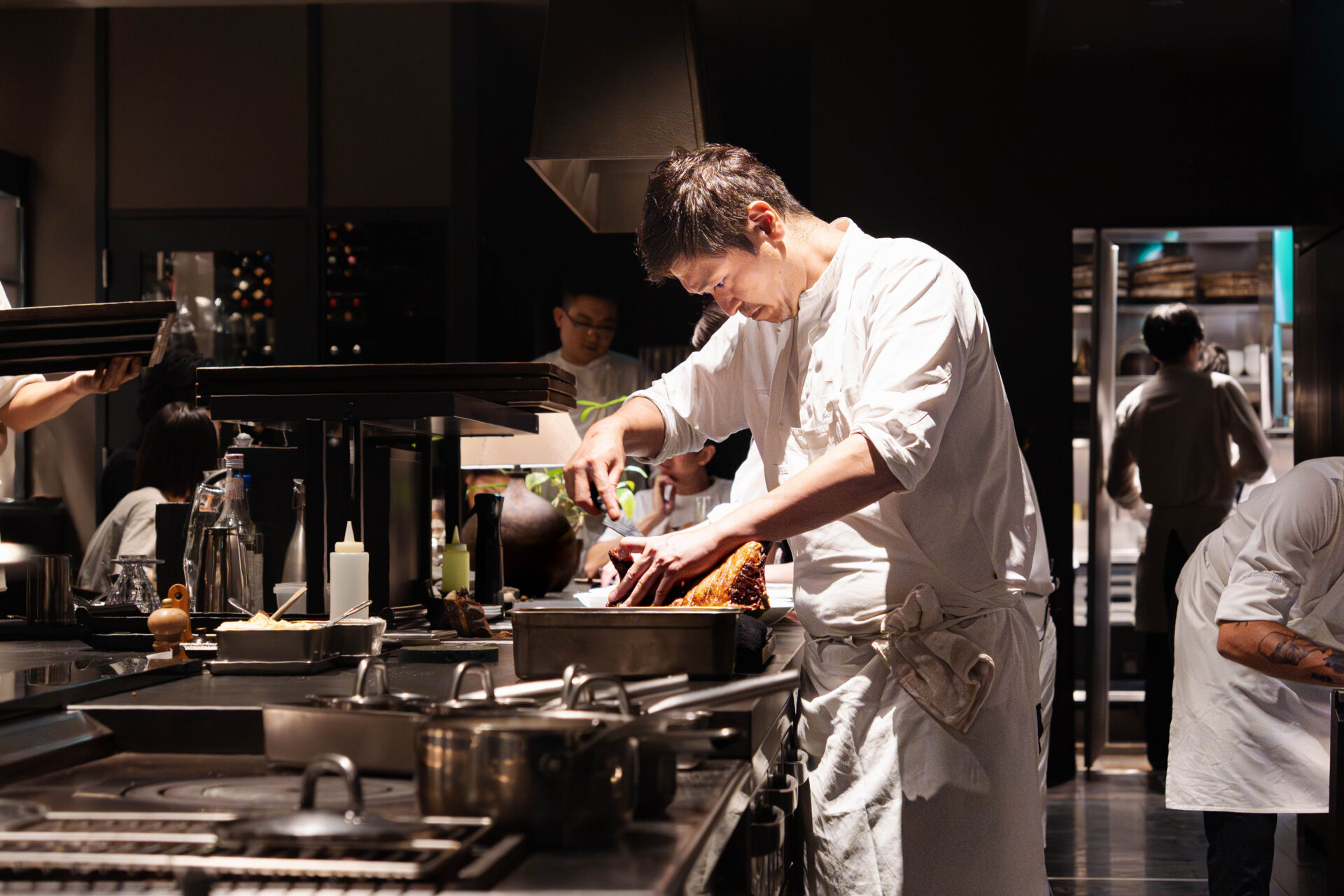
Reservation & Access Information
Reservations
- Reservations can be made online. New slots open daily at 0:00 (JST) for dates up to one month in advance.
- Bookings are available via the official website’s Reservations page, where guests can select their preferred date and number of guests. Fully booked dates will be marked as unavailable.
- Important notice: Same-day cancellations, changes, or reductions in party size may incur a 100% cancellation fee.
- The maximum party size is four guests. Only junior high school students (age 12+) and older are permitted. There are no private rooms — all seating is at the shared counter (table d’hôte style).
Access
- Address: 2F Garden Plaza D, Azabudai Hills, 5-10-7 Toranomon, Minato-ku, Tokyo
- Nearest stations: Kamiyacho Station (Exit 5, Tokyo Metro Hibiya Line) or Roppongi-itchome Station — both within walking distance.
- The dining room features an open-kitchen counter that surrounds the chefs, allowing guests to watch the cooking process up close in Florilège’s signature communal setting.
Opening Hours
- Lunch: 12:00 – 15:00 (last order 12:30)
- Dinner: 18:00 – 22:00 (last order 18:30)
- Closed: Mondays (with occasional irregular holidays). It is recommended to check the reservation calendar for the latest schedule before booking.
Florilège at Azabudai Hills represents a new chapter in Tokyo’s fine dining — one that combines sustainability, creativity, and human connection. Through its plant-based philosophy, table d’hôte format, and innovative pairing program, it redefines what modern gastronomy can be. Every detail, from ingredient sourcing to guest interaction, reflects Chef Hiroyasu Kawate’s belief that food should not only delight the senses, but also inspire awareness and respect for the world that sustains it.
Dining here is more than an act of indulgence — it is a dialogue between nature and humanity, between the past and the future of cuisine. Florilège continues to shine as one of Japan’s most influential restaurants, carrying its message of thoughtful, sustainable gastronomy to the global stage.
- TAGS

